Fast worldwide shipping & premium quality merchandise, place your order now!
- Band Shops See all band shops 0-9 The 69 Eyes A-C Aknestik Amon Amarth Amorphis Appendix Apulanta Arion Aston Kalmari AURI Battle Beast Beast In Black Behemoth Belzebubs Bjørkø Brother Firetribe Brymir Carach Angren Children of Bodom Crownshift D-I Darkwoods My Betrothed Deicide DIRT Egokills Elvenking Emperor Ensiferum Eppu Normaali Fröbelin Palikat Ghost Happoradio Hassisen Kone Hevisaurus Horizon Ignited Horna Huora Hurriganes I Am The Night In Flames Insomnium Iron Maiden Ismo Alanko K-P Kai Hahto Kalmah Kerry King Klamydia Koljosen Tiekiista Kolmas Nainen Lapinlahden Linnut Lasten Hautausmaa Leevi and the Leavings Lähiöbotox Machinae Supremacy Maj Karma Marianas Rest Marko Hietala Meshuggah Nightwish Nyrkkitappelu Old Gods of Asgard Omnium Gatherum Pate Mustajärvi Pauli Hanhiniemi PMMP Poets of the Fall Poisonblack R-Z Raskasta Joulua Reckless Love Rotten Sound Sara Shiraz Lane Sonata Arctica St. Aurora Stereo Terror Stratovarius Swallow the Sun Taiminen Tehosekoitin Tuomari Nurmio Tuomas Holopainen Turisas Tyrantti Uniklubi Viikate Whispered Yö Miscellaneous
- Products Brand Shops Backstage Rock Shop Ilosaarirock Inferno JP Ahonen Olutposti Rockfest Soundi Apparel & Accessories Accessories Hoodies Men's Shirts Women's Shirts Kids Shops Fröbelin Palikat Hevisaurus DVD/Blu-Ray Collections & Campaigns Exclusive T-Shirts Latest Additions Most Popular CD, DVD, Blu-Ray & Vinyl Books Outlet Collections by Genre Death Metal, Black Metal & Doom Symphonic, Melodic & Power Metal Finnish Metal Finnish Rock Hard Rock & Stadion Rock
- Customer Service
- Shipping & Delivery
- Payment Information
- Returns & Exchanges
- Garment Care
- Terms & Conditions
- Terms Of Service
- Privacy Policy
- See all band shops
- The 69 Eyes
- Amon Amarth
- Aston Kalmari
- Battle Beast
- Beast In Black
- Brother Firetribe
- Carach Angren
- Children of Bodom
- Darkwoods My Betrothed
- Eppu Normaali
- Fröbelin Palikat
- Hassisen Kone
- Horizon Ignited
- I Am The Night
- Iron Maiden
- Ismo Alanko
- Koljosen Tiekiista
- Kolmas Nainen
- Lapinlahden Linnut
- Lasten Hautausmaa
- Leevi and the Leavings
- Machinae Supremacy
- Marianas Rest
- Marko Hietala
- Nyrkkitappelu
- Old Gods of Asgard
- Omnium Gatherum
- Pate Mustajärvi
- Pauli Hanhiniemi
- Poets of the Fall
- Poisonblack
- Raskasta Joulua
- Reckless Love
- Rotten Sound
- Shiraz Lane
- Sonata Arctica
- Stereo Terror
- Stratovarius
- Swallow the Sun
- Tehosekoitin
- Tuomari Nurmio
- Tuomas Holopainen
- Miscellaneous
- Brand Shops
- Backstage Rock Shop
- Ilosaarirock
- Apparel & Accessories
- Accessories
- Men's Shirts
- Women's Shirts
- DVD/Blu-Ray
- Collections & Campaigns
- Exclusive T-Shirts
- Latest Additions
- Most Popular
- CD, DVD, Blu-Ray & Vinyl
- Collections by Genre
- Death Metal, Black Metal & Doom
- Symphonic, Melodic & Power Metal
- Finnish Metal
- Finnish Rock
- Hard Rock & Stadion Rock

Sign up today and we'll send you a 10% discount code towards your first purchase. Some restrictions apply.

Nightwish Shop
The official Nightwish online shop is operated by Backstage Rock Shop in co-operation with the band. Feel free to browse the products and buy your favorite merchandise. We ship internationally, every working day.

- Best selling
- Alphabetically, A-Z
- Alphabetically, Z-A
- Price, low to high
- Price, high to low
- Date, old to new
- Date, new to old
- Crewish (3)
- Kai Hahto (4)
- Kangasluoma, Timo (3)
- Nightwish (87)
- Tuomas Holopainen (3)
- Accessories (1)
- Bath Towel (1)
- Beanie Hat (1)
- Blu-Ray (2)
- College Sweater (1)
- Drumsticks (1)
- Kids T-Shirt (1)
- Kids Wear (1)
- Pendant (1)
- Sweater (1)
- T-Shirt (18)
- Vinyl Slipmat (2)
- Women's T-Shirt (7)
- 3 months (1)
- 6 months (1)
- 9 months (1)
- 12 months (1)

Your cart is currently empty.
Continue Shopping
Shopping Cart
100% Officially Licensed Band Merchandise
- Wishlist ( 0 )
- Long Sleeves
- Puzzles & Games
- School Supplies
- Arm, Wrist & Handwear
- Backpacks & Bags
- Belt Buckles
- Neck Ties & Scarves
- Wallets & Handbags
- Posters/Wall Art
- Barware Items
- Blankets, Sheets & Towels
- Candles & Holders
- Coffee & Travel Mugs
- Water Bottles
- Collector Items
- Action Figures
- Funko Figures
- Device Covers & Cases
- DVD/CD/Vinyl
- Books Or Tour, Photos & Tabs
- Headphones & Speakers
- Masks & Costumes
- Stickers & Patches
- Tour, Photos & Tabs
- Amon Amarth
- Avenged Sevenfold
- A Day To Remember
- Alice In Chains
- View All ARTISTS/GROUPS in a
- Alchemy Of England
- View All BRANDS in a
- Adventure Time
- Army Of Darkness
- American Horror Story
- View All ENTERTAINMENT in a
- Black Label Society
- Bring Me The Horizon
- Black Sabbath
- View All ARTISTS/GROUPS in b
- Big League Chew
- Blackcraft Cult
- View All BRANDS in b
- Boondock Saints
- Big Bang Theory
- Breaking Bad
- Big Lebowski
- View All ENTERTAINMENT in b
- Cradle Of Filth
- Cannibal Corpse
- Crown The Empire
- View All ARTISTS/GROUPS in c
- Chiquita Banana
- View All BRANDS in c
- Captain America
- Curious George
- Cheech & Chong
- Clockwork Orange
- Californication
- View All ENTERTAINMENT in c
- Descendents
- View All ARTISTS/GROUPS in d
- Dubble Bubble
- View All BRANDS in d
- Dragon Ball Z
- Dawn Of The Dead
- View All ENTERTAINMENT in d
- View All ARTISTS/GROUPS in e
- View All BRANDS in e
- Edgar Allan Poe
- View All ENTERTAINMENT in e
- Five Finger Death Punch
- Fleetwood Mac
- Faith No More
- Foo Fighters
- Falling In Reverse
- View All ARTISTS/GROUPS in f
- Farts Candy
- View All BRANDS in f
- Friday The 13th
- Ferris Bueller's Day Off
- View All ENTERTAINMENT in f
- Grateful Dead
- Guns N Roses
- View All ARTISTS/GROUPS in g
- General Motors
- View All BRANDS in g
- Green Lantern
- Ghostbusters
- Game Of Thrones
- View All ENTERTAINMENT in g
- Hollywood Undead
- Hot Water Music
- View All ARTISTS/GROUPS in h
- Happy Jesus
- Harley Davidson
- Hello Kitty
- View All BRANDS in h
- Harry Potter
- House Of 1000 Corpses
- How I Met Your Mother
- Hunger Games
- View All ENTERTAINMENT in h
- Insane Clown Posse
- Iron Maiden
- I Declare War
- View All ARTISTS/GROUPS in i
- Inked (Magazine)
- View All BRANDS in i
- Incredible Hulk
- I Dream Of Jeannie
- I Love Lucy
- It's Always Sunny In Philadelphia
- View All ENTERTAINMENT in i
- Jimi Hendrix
- Judas Priest
- Johnny Cash
- Joy Division
- View All ARTISTS/GROUPS in j
- Jack Daniel's
- View All BRANDS in j
- Justice League Of America
- Jeff Dunham
- Jurassic Park
- View All ENTERTAINMENT in j
- King Diamond
- King Crimson
- View All ARTISTS/GROUPS in k
- View All BRANDS in k
- King Of The Hill
- Killer Klowns From Outer Space
- Kung Fu Panda
- View All ENTERTAINMENT in k
- Linkin Park
- Lynyrd Skynyrd
- Lamb Of God
- Led Zeppelin
- View All ARTISTS/GROUPS in l
- View All BRANDS in l
- Les Miserables
- Lord Of The Rings
- View All ENTERTAINMENT in l
- Motley Crue
- View All ARTISTS/GROUPS in m
- Miller Beer
- Mountain Dew
- View All BRANDS in m
- Marvel Comics
- Marilyn Monroe
- Muhammad Ali
- Monty Python
- Mars Attacks!
- View All ENTERTAINMENT in m
- Nine Inch Nails
- View All ARTISTS/GROUPS in n
- Norton Motorcycles
- View All BRANDS in n
- Nightmare On Elm Street
- Night Of The Living Dead
- National Lampoon's Vacation
- View All ENTERTAINMENT in n
- Ozzy Osbourne
- Operation Ivy
- Of Mice & Men
- View All ARTISTS/GROUPS in o
- View All BRANDS in o
- Office Space
- Once Upon A Time
- Orange Is The New Black
- View All ENTERTAINMENT in o
- Parkway Drive
- Pierce The Veil
- View All ARTISTS/GROUPS in p
- Pan American World Airways
- View All BRANDS in p
- Parks And Recreation
- Pulp Fiction
- Pee Wee Herman
- View All ENTERTAINMENT in p
- Queens Of The Stone Age
- Queensryche
- View All ARTISTS/GROUPS in q
- View All BRANDS in q
- Quantum Leap
- Queer As Folk
- Quadrophenia
- View All ENTERTAINMENT in q
- Rolling Stones
- Red Hot Chili Peppers
- View All ARTISTS/GROUPS in r
- Rubik's Cube
- View All BRANDS in r
- Rocky Horror
- Reservoir Dogs
- Rick And Morty
- Rocky & Bullwinkle
- View All ENTERTAINMENT in r
- Suicidal Tendencies
- Sonic Youth
- View All ARTISTS/GROUPS in s
- Shelby Cobra
- View All BRANDS in s
- Sons Of Anarchy
- Speed Racer
- View All ENTERTAINMENT in s
- Tenacious D
- Three Days Grace
- Talking Heads
- View All ARTISTS/GROUPS in t
- Tootsie Roll
- The Mountain
- View All BRANDS in t
- Texas Chainsaw Massacre
- Trailer Park Boys
- Three Stooges
- The Shining
- View All ENTERTAINMENT in t
- Upon A Burning Body
- View All ARTISTS/GROUPS in u
- View All BRANDS in u
- Universal Monsters
- Ultimate Warrior
- Under The Dome
- View All ENTERTAINMENT in u
- Velvet Underground
- Vampire Weekend
- View All ARTISTS/GROUPS in v
- View All BRANDS in v
- Venom (Marvel Comics)
- Vlad The Impaler
- View All ENTERTAINMENT in v
- Wu Tang Clan
- We Came As Romans
- Whitechapel
- View All ARTISTS/GROUPS in w
- White Castle
- View All BRANDS in w
- Walking Dead
- Wonder Woman
- Workaholics
- View All ENTERTAINMENT in w
- View All ARTISTS/GROUPS in x
- View All BRANDS in x
- Xena: Warrior Princess
- View All ENTERTAINMENT in x
- View All ARTISTS/GROUPS in y
- View All BRANDS in y
- Young Frankenstein
- Year Without A Santa Claus
- View All ENTERTAINMENT in y
- View All ARTISTS/GROUPS in z
- View All BRANDS in z
- View All ENTERTAINMENT in z
- View All ARTISTS/GROUPS in other
- View All BRANDS in other
- View All ENTERTAINMENT in other
Nightwish - Officially Licensed Merchandise
Nightwish is a symphonic metal band from Kitee, Finland. The band was formed in 1996. Memebers include; Tuomas Holopainen, Emppu Vuorinen, Jukka Nevalainen, Marco Hietala, Troy Donockley, Floor Jansen. Discography Includes; Angels Fall First (1997), Oceanborn (1998), Wishmaster (2000), Century .... Show More Child (2002), Once (2004), Dark Passion Play (2007), Imaginaerum (2011), Endless Forms Most Beautiful (2015). Tours include; Dark Passion Play, Endless Forms Most Beautiful, Imaginaerum World Tour, Oceanborn Europe Tour, Once Upon a Tour, Summer of Wilderness, The First Tour of the Angels, Wishmaster World Tour, World Tour of the Century. Show Less
Oops! there are no products in this collection.
But check out our top trending products..

NIGHTWISH Endless Forms Tour Dates T-shirt

NIGHTWISH Owl Summer Festivals 2016 Tour T-shirt

NIGHTWISH Logo Owl Zippered Hooded Sweatshirt

NIGHTWISH Scarf Neck Ties & Scarves

NIGHTWISH Endless Forms Most Beautiful Tour Hammerstein T-shirt

NIGHTWISH Logo Beanie

NIGHTWISH Logo Athletic Wristband

NIGHTWISH Owl 2016 Tour Zippered Hooded Sweatshirt

NIGHTWISH Hvman Natvre Slim Fit T-shirt

NIGHTWISH Owl 2016 Tour Junior Top

NIGHTWISH Imaginaerum Tour Dates 2013 T-shirt

NIGHTWISH April 30th House Of Blues Las Vegas T-shirt

NIGHTWISH Tour Program Tour Book

NIGHTWISH Endless Forms Beanie

NIGHTWISH Endless Forms Summer Festivals 2016 T-shirt

NIGHTWISH Endless Forms Most Beautiful Tour Palladium T-shirt

NIGHTWISH Endless Forms Most Beautiful Tour Electric Factory T-shirt

NIGHTWISH Endless Forms Most Beautiful Tour Le Capitole T-shirt

NIGHTWISH April 26th Crystal Ballroom T-shirt

NIGHTWISH May 1st The Greek Theatre Los Angeles CA T-shirt

NIGHTWISH April 28th Warfield T-shirt

NIGHTWISH April 16th Town Ballroom T-shirt

NIGHTWISH April 25th Orpheum Theatre T-shirt

NIGHTWISH Imaginaerum Junior Top

NIGHTWISH April 22nd In The Venue T-shirt

NIGHTWISH April 24th Knitting Factory T-shirt

NIGHTWISH Endless Forms Tour Dates Junior Top

NIGHTWISH April 18th Concorde Music Hall T-shirt

NIGHTWISH Endless Forms Most Beautiful Tour Phoenix Concert T-shirt

NIGHTWISH Once 2 Poster Flag

NIGHTWISH April 19th 7 Flags Event Center T-shirt

NIGHTWISH April 21st Ogden Theatre T-shirt
Featured genres.

Classic Rock

Indie Merch

Alternative Rock
- Win Upheaval Fest Tix
- Album Release Calendar
- Festival Guide
- Heavy History

Nightwish Announce 10-Date North American 2022 Tour With Beast in Black
Symphonic metal masters Nightwish are plotting their return to North America with a 10-date tour booked for May of next year as the veteran Finnish band continues to support their latest album, Human :||: Nature .
The run, which also features special guest Beast in Black , marks Nightwish's long-awaited return to the United States and Canada after what will be a four-year absence by the time the first show is underway on May 4 in Toronto, Ontario. Despite a prolonged period of time between North American tours, this upcoming jaunt will only be hitting select cities with three of the 10 shows taking place in California, including back-to-back nights in Los Angeles to cap it off.
While Nightwish will be touting their ambitious 2020 full length, power metal mavens Beast in Black, also from Finland, will be out in support of this year's Dark Connection , their third album.
See the complete list of dates below. For tickets, head to Nightwish's website .
Nightwish 2022 North American Tour Dates
May 04 — Toronto, Ontario @ History May 06 — Montreal, Quebec @ Mtelus May 07 — Lowell, Mass. @ Tsongas Arena May 08 — New York, N.Y. @ Terminal 5 May 10 — Silver Spring, Md. @ The Fillmore May 12 — Chicago, Ill. @ Radius May 13 — St. Paul, Minn. @ The Fillmore May 15 — Denver, Colo. @ Mission Ballroom May 18 — San Francisco, Calif. @ The Warfield May 20 — Los Angeles, Calif. @ The Wiltern May 21 — Los Angeles, Calif. @ The Wiltern
Top 25 Power Metal Albums of All Time
More from loudwire.


Your browser's Javascript functionality is turned off.
Please turn it on so that you can experience the full features of this site.
By clicking “Agree” you allow us to use cookies on our website, social media and partner websites in order to improve and personalize our shop, and for analysis and marketing purposes. Alternatively you can choose not to agree to the use of cookies – in this case we will only use the essential cookies. By clicking on “Set preferences” you can set your cookie preferences. You can change the cookie settings and revoke your permission at any time on the cookie policy page . You can find more information in our data data protection guidelines .
With the help of this tool you can select and deactivate tracking & analytics tools used on this website
Your browser is currently not set to accept cookies.
Please turn this functionality on or check if you have another program set to block cookies.

Sorry, we couldn't find any matches for your search

Designed by EMP

Exclusive to EMP

Sustainable at EMP

Nightwish merchandise
If someone had said twenty years ago that opera and metal would go together wonderfully, people would have thought they were crazy. But with the foundation of Nightwish in 1996, the victory march of a band based on exactly that concept began. Founded by songwriter and keyboardist Tuomas Holopainen, guitarist Emppu Vuorinen and singer Tarja Turunen, the band released their first album, Angels Fall First, in 1997. Since then, the symphonic metal band has formed the basis for a whole new genre, and become Finland’s most successful metal band.
In the EMP Nightwish Online Shop, you’ll find all the Nightwish merchandise you could possibly need to show your love for the band. Whether you’re looking for T-shirts, hoodies or accessories, you’re in exactly the right place.
Nightwish’s style is strongly inspired by film music. As well as classical and romantic elements, the band also bring in elements of folk music and influences from Celtic and Arabic music. In particular, the style of older Nightwish albums is marked by the combination of the classically-trained soprano voice of Tarja Turunen and the keyboard-heavy power metal sound. In fact, the band’s style has become so popular that it has inspired a whole new generation of symphonic and power metal bands.
The band’s lyrics are mostly based around mythology and fantasy. Over time, though, more personal content was introduced, such as the song Dead Boy’s Poem from the album Wishmaster, which Nightwish songwriter Tuomas Holopainen described as his ‘legacy to the entire world’. On the album Dark Passion Play, there are several songs about the childhood and life of individual band members.
Tarja Turunen parts ways with the band
After a line-up change in the year 2008, the Finns continued their upward trajectory with former Alyson Avenue frontwoman Anette Olzon at the helm. Their sixth studio album Dark Passion Play reached platinum status on the first day, and went to number one in the charts in several countries.
In 2012, Nightwish announced that they were parting ways with Anette Olzon. She was replaced by former After Forever vocalist Floor Jansen, whilst Uilleann pipe player and multi-instrumentalist Troy Donockley, who had previous played with the band on numerous occasions, became a permanent member. In 2015, the band released their most recent album Endless Forms Most Beautiful featuring Floor’s incredible vocals and powerful songs such as ‘Shudder Before the Beautiful’ and the single ‘Elan’. The album yet again managed to reach number one in several countries, including number one in the UK Rock & Metal Album Charts. We can’t wait to see what will come next from the band!
Nightwish merchandise in the EMP fan shop
At EMP, you can of course find all the albums from your favourite band, with a range of vinyls as well as CDs and DVDs, as well as loads more Nightwish merchandise. Show your support for the Finnish symphonic metal maestros with one of our Nightwish T-shirts for men and women, featuring both old and new album artwork. Or why not stay warm during the cold Finnish winters with a cosy Nightwish hoodie or jumper? So what are you waiting for? Get down to the EMP Nightwish Online Shop and stock up on all the merchandise you need. See you at the next concert! Still not enough metal merch for you? Check out our Alestorm, Ensiferum, Blind Guardian and Powerwolf shops too!
FREE DOMESTIC SHIPPING ON ORDERS $75+

Item added to your cart
- T-Shirt (9)
10 products
Filter and sort, human nature 2022 tour t-shirt, human nature 2023 t-shirt, since 1996 tour 2022 t-shirt, blue rose t-shirt, wish master decades north american tour t-shirt, imagine north american t-shirt, emblem logo black 9" beanie, decades tour north america t-shirt, dark passion play decades black t-shirt, angels fall first decades t-shirt.
- Choosing a selection results in a full page refresh.
- Bands ( 0 )
- Groups ( 0 )
- Members ( 0 )
- Forums ( 0 )
World's largest community of heavy metal tshirt and battlejacket collectors.
- Sale / Trade
- ShopReviews
- Upload to Gallery

To view this video please enable JavaScript, and consider upgrading to a web browser that supports HTML5 video
Nightwish - European Tour 2022

TSHIRTSLAYER 16 TH BIRTHDAY IN...
Guess this tshirt.

Recent Comments

Recent Trades / Sells
Heavy Metal Merchandise Collectors Gallery ‐ TSHIRTSLAYER, we are the worlds largest community of heavy metal tshirt, patches and battle jacket (kutten) collectors in the world, show your collection, maybe even buy, sell or trade a few nice items. We want photos of your heavy metal tshirts to keep for future generations! (All posts are Copyright by their TSS Member under creative commons 3.0).


- Search for:
- Track Order
No products in the cart.
- Janet Jackson Tour Shirt
- Eagles Batman Shirt
- Karma Is A Cat Shirt
- Karma Is My Boyfriend Shirt
- Big Cock Brock Shirt
- Jeff Stoutland University Shirt
- Keeper Of The Lost Cities Shirt
- Moms Against White Baseball Pants Shirt
- Disney Mardi Gras Shirts
- Dancing On My Own Shirt
- Billsgiving Shirt
- Jeffrey Dahmer Shirt
- Morgan Wallen 98 Braves Shirt
- Metallica 72 Seasons Shirt
- I Look Better Bent Over Shirt
- Lisa Marie Presley Shirt
- Bruce Springsteen 2023 Tour Shirt
- Daisy Jones And The Six Shirt
- Andrew Tate Top G Shirt
- FAMILY GIFT IDEAS
- HOLIDAY GIFT IDEAS

Nightwish European Tour 2022 Shirt, Human Ii Nature Short Sleeve Crewneck

Forest Green
Irish Green
Dark Heather
- Total: $ 0.00
— OR —

Related products

Nightwish Human Ii Nature European Tour Shirt, Music Festival Crewneck Short Sleeve
- Description
- Shipping information
Nightwish European Tour 2022 Shirt, Human Ii Nature Short Sleeve Crewneck is the shirt that anyone can wear! It doesn't matter if you're a girl or boy, mom or dad - this shirt is for you. It's comfortable, stylish, and perfect for any occasion. Whether you're headed to the gym or out for a night on the town, this shirt will make you look great.

- Fabric Weight: 5.3 oz (mid-weight). 100% pre-shrunk cotton (heather gray color is 90% cotton/10% polyester, light heather gray is 98% cotton/2% polyester, heather black is 50% cotton/50% polyester)
- Double-stitched seams at shoulder, sleeve, collar and waist
- Special Note: Mineral Wash colors have a slight yellow tint and not one is the same due to the special dye process
- Processed and printed in the U.S.A.
- Printed: All products are proudly printed in the United States.
- Production Time: All orders are processed within 1 - 2 business days.
- Processing Time: It takes 1 - 2 days to ship your order to our warehouse, put your name and address on it and ship out.
- Shipping Time: You will receive your order anywhere from 3 - 7 business days (depending on the shipping method you chose) from the date that it is shipped out, not the date the order is placed.
- Return & Exchange: A full-refund of your purchase! Absolutely risk-free, no question asked. In case of defective or damaged goods, we will send a replacement to you (No any extra fee) within 30 days since your purchase.
- Tracking Number: When available, we will send you the tracking number with the confirmation email so that you can track the package online.
- Worldwide Shipping Available: At 9TeeShirt, we ships products to over 100 countries worldwide. Shipping rates and fees may vary depending on your country or region.
- If you have any other queries, please feel free to email us at [email protected]
Username or email address *
Password *
Remember me Log in
Firebird Travel
RUSSIA TRAVEL HOME
Thank you for your enquiry.
RUSSIA TRAVEL PACKAGES A selection of Russian tours to take as they are or adjust to your needs.
THE GOLDEN RING Visit the heart of ancient Russia. What is the Golden Ring?
MOSCOW TOURS What you can see in Moscow.
MOSCOW DAY TRIPS Get out of Moscow and take a relaxing trip to some of these places
ST. PETERSBURG Some of the sights to see in Petersburg
LAKE BAIKAL TOURS Hiking and trekking around the world's deepest lake in the heart of Siberia
RUSSIAN DIGS Come and work in the field on a Russian Archaeological dig. Full training given on site.
TRAVEL TIPS & SERVICES Getting around in Russia
If you do not receive a confirmation email shortly then you have probably incorrectly entered your email.
Number of travelers ">
Special Interests or requests. "> ">
If you experience difficulties please use this link to send Regular Email . All information is treated as confidential
Moscow Metro Tour
- Page active

Description
Moscow metro private tours.
- 2-hour tour $87: 10 Must-See Moscow Metro stations with hotel pick-up and drop-off
- 3-hour tour $137: 20 Must-See Moscow Metro stations with Russian lunch in beautifully-decorated Metro Diner + hotel pick-up and drop off.
- Metro pass is included in the price of both tours.
Highlight of Metro Tour
- Visit 10 must-see stations of Moscow metro on 2-hr tour and 20 Metro stations on 3-hr tour, including grand Komsomolskaya station with its distinctive Baroque décor, aristocratic Mayakovskaya station with Soviet mosaics, legendary Revolution Square station with 72 bronze sculptures and more!
- Explore Museum of Moscow Metro and learn a ton of technical and historical facts;
- Listen to the secrets about the Metro-2, a secret line supposedly used by the government and KGB;
- Experience a selection of most striking features of Moscow Metro hidden from most tourists and even locals;
- Discover the underground treasure of Russian Soviet past – from mosaics to bronzes, paintings, marble arches, stained glass and even paleontological elements;
- Learn fun stories and myths about Coffee Ring, Zodiac signs of Moscow Metro and more;
- Admire Soviet-era architecture of pre- and post- World War II perious;
- Enjoy panoramic views of Sparrow Hills from Luzhniki Metro Bridge – MetroMost, the only station of Moscow Metro located over water and the highest station above ground level;
- If lucky, catch a unique «Aquarelle Train» – a wheeled picture gallery, brightly painted with images of peony, chrysanthemums, daisies, sunflowers and each car unit is unique;
- Become an expert at navigating the legendary Moscow Metro system;
- Have fun time with a very friendly local;
- + Atmospheric Metro lunch in Moscow’s the only Metro Diner (included in a 3-hr tour)
Hotel Pick-up
Metro stations:.
Komsomolskaya
Novoslobodskaya
Prospekt Mira
Belorusskaya
Mayakovskaya
Novokuznetskaya
Revolution Square
Sparrow Hills
+ for 3-hour tour
Victory Park
Slavic Boulevard
Vystavochnaya
Dostoevskaya
Elektrozavodskaya
Partizanskaya
Museum of Moscow Metro
- Drop-off at your hotel, Novodevichy Convent, Sparrow Hills or any place you wish
- + Russian lunch in Metro Diner with artistic metro-style interior for 3-hour tour
Fun facts from our Moscow Metro Tours:
From the very first days of its existence, the Moscow Metro was the object of civil defense, used as a bomb shelter, and designed as a defense for a possible attack on the Soviet Union.
At a depth of 50 to 120 meters lies the second, the coded system of Metro-2 of Moscow subway, which is equipped with everything you need, from food storage to the nuclear button.
According to some sources, the total length of Metro-2 reaches over 150 kilometers.
The Museum was opened on Sportivnaya metro station on November 6, 1967. It features the most interesting models of trains and stations.
Coffee Ring
The first scheme of Moscow Metro looked like a bunch of separate lines. Listen to a myth about Joseph Stalin and the main brown line of Moscow Metro.
Zodiac Metro
According to some astrologers, each of the 12 stops of the Moscow Ring Line corresponds to a particular sign of the zodiac and divides the city into astrological sector.
Astrologers believe that being in a particular zadiac sector of Moscow for a long time, you attract certain energy and events into your life.
Paleontological finds
Red marble walls of some of the Metro stations hide in themselves petrified inhabitants of ancient seas. Try and find some!
- Every day each car in Moscow metro passes more than 600 km, which is the distance from Moscow to St. Petersburg.
- Moscow subway system is the 5th in the intensity of use (after the subways of Beijing, Tokyo, Seoul and Shanghai).
- The interval in the movement of trains in rush hour is 90 seconds .
What you get:
- + A friend in Moscow.
- + Private & customized Moscow tour.
- + An exciting pastime, not just boring history lessons.
- + An authentic experience of local life.
- + Flexibility during the walking tour: changes can be made at any time to suit individual preferences.
- + Amazing deals for breakfast, lunch, and dinner in the very best cafes & restaurants. Discounts on weekdays (Mon-Fri).
- + A photo session amongst spectacular Moscow scenery that can be treasured for a lifetime.
- + Good value for souvenirs, taxis, and hotels.
- + Expert advice on what to do, where to go, and how to make the most of your time in Moscow.
Write your review
- Phone: +90 (212) 875 19 08
- E-Mail: [email protected]
- Company Profile
- Company Policy
- Mission and Vision
- Certificates
- Aluminium Windows
- Aluminium Doors
- Aluminium Sliding Elements
Aluminium Curtain Walls
- Aluminium Skylight Elements
- Aluminium Frames for Safety and Security
- Aluminium Conservatories
- Metal Panel Sheet Claddings
- Aluminium Entrance Frames
- Glass Structures
- Complementary Items
- Lightweight Steel Structures
- Human Resources OPEN
Stick Facade Structures
Semi-unitized facade structures, unitized facade structures with aluminium capping, semi and fully structural silicone glazed versions.
Nightwish announce HUMAN. :II: NATURE. (Tour Edition)

In the past two years, Symphonic metal super stars NIGHTWISH have been affected by the cancellations and restrictions just like many other artists out there, and could not present their highly successful Human. :II: Nature. album (No. 1 in Finland and Germany) with live shows all across the globe yet. Now, this is about to change with a full European tour taking place in November and December 2022. As a special, limited release right on time with tour start, on November 18 th , NIGHTWISH present the Human. :II: Nature. (Tour Edition) as luxurious 2CD plus Blu-ray Digipak including the recent album alongside the Virtual Live Show From The Islanders Arms 2021 on Blu-ray - region code free for the first time - to cater their gigantic global audience! Originally available just as DVD release, and on Blu-ray in Japan, this new edition is the ultimate version to re-experience this unique and magical show NIGHTWISH created after their world tour had to be cancelled. Half a year in preparation and premiered on May 28 and May 29, 2021 , An Evening with Nighwish in a Virtual World was not just a regular streaming show. It was an exceptionally ambitious production, allowing fans to follow the band playing live in an astonishing 3D world, designed according to the band’s vision, while interacting with each other. Also, songs from NIGHTWISH ’s latest album Human. :II: Nature. were debuted live to a massive audience consisting of more than 150.000 fans from 108 countries! “This is definitely one of the coolest things NIGHTWISH has ever done”, the band comments. “Entwining visual elements, technology and music in such an extraordinary way offers a unique experience to us all.” About 30 people from seven different countries, many of them long-time fans, put everything they had into the game to craft a high quality virtual concert featuring a NIGHTWISH -themed tavern, elaborate animations and 3D models that provided an atmospheric and inimitable stage for the group’s 100 minutes long, stellar career-spanning set brilliantly mastered by Mika Jussila at Finnvox. So, while you, dear NIGHWISH fans, can look forward to see Floor, Tuomas, Emppu, Troy, Jukka, and Kai for real again at many sold out shows in the upcoming months, the Human. :II: Nature. (Tour Edition) invites you to revisit a one-of-a-kind event unique in the band’s history. Pre-order HUMAN. :II: NATURE. (Tour edition) here: https://nightwish.bfan.link/human-nature-tour-edition Celebrating the announcement, NIGHTWISH release a stunning video for 'Noise' taken from the An Evening with Nightwish in a Virtual World show today: https://youtu.be/LrV-8eXEVd4

The tracklisting will read as follows: CD 1: Human. :II: Nature. 01. Music 02. Noise 03. Shoemaker 04. Harvest 05. Pan 06. How's The Heart? 07. Procession 08. Tribal 09. Endlessness CD 2: All the Works of Nature Which Adorn the World 01. All The Works Of Nature Which Adorn The World - Vista 02. All The Works Of Nature Which Adorn The World - The Blue 03. All The Works Of Nature Which Adorn The World - The Green 04. All The Works Of Nature Which Adorn The World - Moors 05. All The Works Of Nature Which Adorn The World - Aurorae 06. All The Works Of Nature Which Adorn The World - Quiet As The Snow 07. All The Works Of Nature Which Adorn The World - Anthropocene (incl. "Hurrian Hymn To Nikkal") 08. All The Works Of Nature Which Adorn The World - Ad Astra Blu-ray: Virtual Live Show From The Islanders Arms 2021 1.Intro 1:46 2.Noise 5:15 3.Planet Hell 4:40 4.Alpenglow 4:43 5.Élan 4:21 6.Storytime 5:35 7.How's the Heart? 4:53 8.Harvest 5:31 9.Dark Chest of Wonders 4:23 10.I Want My Tears Back 5:24 11.Ever Dream 4:47 12.Nemo 5:23 13.Sleeping Sun 4:25 14.Pan 5:17 15.Last Ride of the Day 4:44 16.Ghost Love Score 10:30 17.The Greatest Show on Earth 16:41 18.All the Works of Nature Which Adorn the World: VIII. Ad Astra 3:36
2004 tsunami india case study
Environmental hazards case study: indian ocean tsunami 2004.
Understanding why natural hazards occur can help countries to manage or prevent their consequences. Case studies illustrate the impact of natural hazards in the short and long term.
Part of Geography Global issues
Case study: Indian Ocean Tsunami 2004
Indian ocean tsunami 2004.
A very common case study for earthquakes is the South-East Asian tsunami of 2004. Other case studies include Mexico 1985, San Francisco 1989, Kobe 1995 and Pakistan 2005.
This video can not be played
To play this video you need to enable JavaScript in your browser.
The causes and effects of the 2004 Asian tsunami

The underlying causes
On 26 December 2004 there was a massive and sudden movement of the Earth’s crust under the Indian Ocean. This earthquake was recorded at magnitude close magnitude The size or severity of something. For example, an earthquake. 9 on the Richter Scale close Richter scale The measure by which the strength of earthquakes is determined. and as it happened under the ocean, caused a devastating sea wave called a tsunami.
The epicentre close epicentre The point on the Earth's surface directly above the focus of an earthquake. of the earthquake occurred 200 kilometres west of the island of Sumatra in the Indian Ocean. The earthquake itself was caused by the subduction close subduction When one crustal plate is forced beneath the other. of the Indo-Australian plate under the Eurasian plate.
As the Indian plate (part of the Indo-Australian plate) moved underneath the Burma plate (part of the Eurasian plate) the crustal rocks stuck as they moved past one another. At 08:00 local time, the pressure build up was too great and the crustal rocks snapped, causing an earthquake.
When this happened the sea floor close sea floor The bottom of the ocean. was pushed upwards displacing a huge volume of water and creating the devastating tsunami waves.
Impact on landscape and population
- Some smaller islands in the Indian Ocean were completely destroyed.
- Coastal buildings were completely destroyed making people homeless.
- Fishing villages close fishing villages A small settlement where the main activity is catching fish. were completely destroyed.
- Lines of communication close lines of communication This refers to telephone cables and electricity power lines as well as roads and railways. , including phone lines, were cut off.
- Electricity power lines were cut off.
- Roads and railways were destroyed.
- Fires broke out due to severed water pipes.
- Approximately 250,000 people are estimated to have been killed, including many tourists close tourist Someone who travels for recreation or business purposes. on the beaches of Thailand.
- There was an outbreak of diseases such as cholera due to a lack of fresh water supplies.
- There was a lack of food as many fish died and farms were destroyed.
- Thousands of people were made homeless.
- Thousands of people lost their jobs as tourist hotels in Thailand were destroyed and fishing vessels were washed ashore.
More guides on this topic
- Climate change
- Natural regions
- Trade and globalisation
- Global tourism
- Classroom Videos
Related links
- BBC Weather
- BBC News: Science, Environment
- BBC Two: Landward
- SQA National 5 Geography
- Planet Diary
- Scotland's Environment
- Royal Geographical Society
Subscribe Now! Get features like

- Latest News
- Entertainment
- Real Estate
- KKR vs RCB Live Score
- UP Board Result
- Election Schedule 2024
- Win iPhone 15
- IPL 2024 Schedule
- IPL Points Table
- IPL Purple Cap
- IPL Orange Cap
- AP Board Results 2024
- The Interview
- Web Stories
- Virat Kohli
- Mumbai News
- Bengaluru News
- Daily Digest

2004 Indian Ocean tsunami: 17 years on, a look back at one of the deadliest natural disasters in history
Triggered by the undersea earthquake activity offshore, the 100-feet-high tsunami waves laid bare complete annihilation in as many as 14 countries, making it one of the deadliest natural disasters in recorded history.
December 26, 2021, marks 17 years since the devastating Indian Ocean earthquake and tsunami of 2004 which struck the coasts of multiple countries in south and southeast Asia and took a fatal toll on the population there.
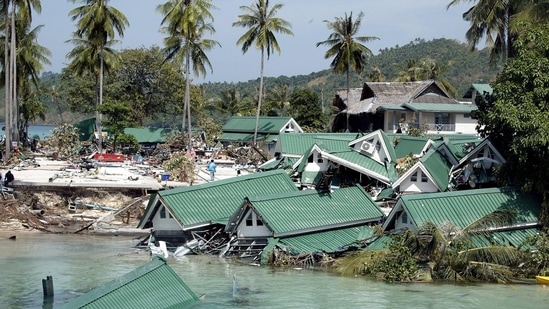
Listed among the worst calamities in this part of the world, more than 230,000 people across India, Sri Lanka, Maldives, Thailand, and Indonesia were and the countries sustained billions of dollars worth of damages to property after the 100-foot tsunami triggered by a magnitude 9.1 earthquake.
The 2004 Indian Ocean Tsunami is also known as the Boxing Day Tsunami or, in the scientific community, the Sumatra-Andaman earthquake. According to a report by CNN, the tremors were so powerful that it was one of those rare instances when the entire planet vibrated and no place on Earth escaped movement.
“Globally, this earthquake was large enough to basically vibrate the whole planet as much as half an inch, or a centimeter,” the report quoted an associate professor of geosciences at the Penn State University in the United States. “Everywhere we had instruments, we could see motions.”
Here's all you need to know about the 2004 Indian Ocean tsunami on its 17th anniversary:
Where was the epicentre of the earthquake?
The undersea megathrust earthquake, which registered a magnitude of 9.1-9.3, originated from an epicentre off the west coast of northern Sumatra in Indonesia, caused by a rupture along the fault line between the Burma Plate and the Indian Plate.
The earthquake was immediately felt in India, Bangladesh, Myanmar, Sri Lanka, Malaysia, Thailand, and the Maldives. In its aftermath, the tsunami followed and, as a result of the seafloor popping up, the height and intensity of the tsunami waves were greatly increased and it led to the destruction of communities along the surrounding coasts of the Indian Ocean.
Among deadliest natural disasters in recorded history
According to geological estimates, the 2004 earthquake was the third-largest of its type to ever be recorded, and it managed to even trigger aftershocks as far away as in Alaska. The plight of the affected people and countries prompted a worldwide humanitarian response, with donations totalling more than $14 billion.
Indonesia, hit worst by the disaster, was however no stranger to earthquakes, lying between the Pacific Ring of Fire and the Alpide Belt along the south and west. The 2002 Sumatra earthquake is, in fact, believed to have been a foreshock to this main event.
Tsunami waves more destructive than WWII nuclear bombs
According to Tad Murty, the vice president of the Tsunami Society, the total energy of the 2004 tsunami waves (the large, destructive waves slowed down near the coast and reached 80-100 feet in height) was equivalent to about five megatons of TNT (21 PJ), which is more than twice the total explosive energy used during all of World War II including the two atomic bombs.
A tsunami researcher and forecaster with the National Oceanic and Atmospheric Administration Center for Tsunami Research, Vasily Titov, also cites the destructive capacity of the 2004 tsunami to the earthquake in the megathrust fault, “where heavy oceanic plates subduct beneath lighter continental plates”.
“They are the largest faults in the world and they’re all underwater,” History quoted him as saying. He added that the tsunami waves could be seen like a large pebble falling in the ocean causing mega ripples.
An eye-opener for India
The Sumatra earthquake and tsunami are considered to be an eye-opener for India as they introduced the Indian coastline to tsunami and its destructible power. Learning from the unprecedented natural disaster that led to such heavy damage to life and property, the Ministry of Earth founded the Indian Tsunami Early Warning System (ITEWS) at Indian National Centre for Ocean Information Services (INCOIS), Hyderabad in October 2007.
Scientists in India are now able to predict and project movements in the Indian Ocean through real-time seismic monitoring with Bottom Pressure Recorders (BPR), tide gauges, and a 24x7 operational tsunami warning system to detect tsunamigenic earthquakes as to provide early advisories to the most vulnerable.
India eventually became the first country to establish an early warning system for tsunami detection, while Odisha became the first state in the country to get a Tsunami Ready recognition.
- Tsunami Threat
- Indonesia Tsunami
- Tsunami Warning
Join Hindustan Times
Create free account and unlock exciting features like.

- Terms of use
- Privacy policy
- Weather Today
- HT Newsletters
- Subscription
- Print Ad Rates
- Code of Ethics
- Elections 2024
- DC vs SRH Live Score
- India vs England
- T20 World Cup 2024 Schedule
- IPL 2024 Auctions
- T20 World Cup 2024
- Cricket Teams
- Cricket Players
- ICC Rankings
- Cricket Schedule
- Other Cities
- Income Tax Calculator
- Budget 2024
- Petrol Prices
- Diesel Prices
- Silver Rate
- Relationships
- Art and Culture
- Taylor Swift: A Primer
- Telugu Cinema
- Tamil Cinema
- Exam Results
- Competitive Exams
- Board Exams
- BBA Colleges
- Engineering Colleges
- Medical Colleges
- BCA Colleges
- Medical Exams
- Engineering Exams
- Horoscope 2024
- Festive Calendar 2024
- Compatibility Calculator
- The Economist Articles
- Explainer Video
- On The Record
- Vikram Chandra Daily Wrap
- PBKS vs DC Live Score
- KKR vs SRH Live Score
- EPL 2023-24
- ISL 2023-24
- Asian Games 2023
- Public Health
- Economic Policy
- International Affairs
- Climate Change
- Gender Equality
- future tech
- Daily Sudoku
- Daily Crossword
- Daily Word Jumble
- HT Friday Finance
- Explore Hindustan Times
- Privacy Policy
- Terms of Use
- Subscription - Terms of Use
Comprehending the Indian Ocean Tsunami: Dec 26, 2004
Case study: e-book.
This web-exhibit should be cited as the following: Vernekar, S. & Kant, V., Comprehending the Indian Ocean Tsunami:Dec 26, 2004. Retrieved from https://www.dsource.in/case-study/comprehending-indian- ocean-tsunami

"Hazards are natural, disasters are not - Terry Canon"
The book revisits the 2004 Indian Ocean Tsunami and it’s aftermath from the viewpoint of resilience and vulnerability. Vulnerability is a multi-faceted concept that lies at the intersection of diversity of risks and their actualization in everyday lived experience. Vulnerability is not the property of people but it is a relational outcome of complex relationships between people and their ecologies in the face of hazards. Understanding disasters such as these from the viewpoint of vulnerability presents real insights into realizing how the disaster is an outcome of multiple interweaving processes at several layers of abstraction. These range from local and global processes related to the social, economic and cultural abilities and coping mechanisms of communities in transition. In this book we emphasize the adaptibility, capacity, vulnerability and resilience in the wake of disasters.
Click here to view at the D'Source portal

Case study: Indian Ocean, 2004
- Electronics
1.3.5 Prediction, preparation and protection
2.1 components of an ecosystem.
- On December 20, a magnitude 9.0 earthquake triggered a tsunami across the coastlines of the Indian Ocean
- 1600 km of fault surface ruptured about 15 m along the subduction zone of the Indian plate under the Burma plate, displacing an estimated 30 cubic kilometres of water, sending is at 500 to 1000 km/h to the coast, where the wave reached heights of 30 m
- The earthquake and tsunami were felt in Bangladesh, India, Malaysia, Myanmar, Singapore, Thailand and the Maldives
- It is the most devastating tsunami in history
- Over 200 thousand people died
- 5 million people left homeless without adequate food, water or sanitation
- In Indonesia, over 150 thousand people were killed, 30 thousand in Sri Lanka and 15 thousand in India
- 410 houses destroyed
- Local economies devastated, especially coastal fishing communities, where two-thirds of the infrastructure were destroyed
- The earthquake & tsunami caused considerable damage to local ecosystems
- 2 million people lost their jobs and an estimated 4 million fell into poverty
- Tourism was affected, even in places that weren’t closed, due to psychological aversion
- Damage to sewage caused the spread of liquid waste, industrial chemicals and polluted water, further damaging the environment
- Sanitation and fresh water were provided to prevent the spread of disease
- Over $10 billion pledged to help those affected
- The World Food Programme provided food for over 1.3 million people
- The Indian Ocean Tsunami Warning system was set up, and functioned successfully for the 2012 Indian Ocean earthquakes
- The Australian government sent ecological experts to the Maldives to help restore the marine environment
A Decade After the 2004 Indian Ocean Tsunami: The Progress in Disaster Preparedness and Future Challenges in Indonesia, Sri Lanka, Thailand and the Maldives
- Open access
- Published: 18 July 2015
- Volume 172 , pages 3313–3341, ( 2015 )
Cite this article
You have full access to this open access article
- Anawat Suppasri 1 ,
- Kazuhisa Goto 1 ,
- Abdul Muhari 2 ,
- Prasanthi Ranasinghe 3 ,
- Mahmood Riyaz 4 ,
- Muzailin Affan 5 ,
- Erick Mas 1 ,
- Mari Yasuda 1 &
- Fumihiko Imamura 1
55k Accesses
61 Citations
3 Altmetric
Explore all metrics
The 2004 Indian Ocean tsunami was one of the most devastating tsunamis in world history. The tsunami caused damage to most of the Asian and other countries bordering the Indian Ocean. After a decade, reconstruction has been completed with different levels of tsunami countermeasures in most areas; however, some land use planning using probabilistic tsunami hazard maps and vulnerabilities should be addressed to prepare for future tsunamis. Examples of early-stage reconstruction are herein provided alongside a summary of some of the major tsunamis that have occurred since 2004, revealing the tsunami countermeasures established during the reconstruction period. Our primary objective is to report on and discuss the vulnerabilities found during our field visits to the tsunami-affected countries—namely, Indonesia, Sri Lanka, Thailand and the Maldives. For each country, future challenges based on current tsunami countermeasures, such as land use planning, warning systems, evacuation facilities, disaster education and disaster monuments are explained. The problem of traffic jams during tsunami evacuations, especially in well-known tourist areas, was found to be the most common problem faced by all of the countries. The readiness of tsunami warning systems differed across the countries studied. These systems are generally sufficient on a national level, but local hazards require greater study. Disaster reduction education that would help to maintain high tsunami awareness is well established in most countries. Some geological evidence is well preserved even after a decade. Conversely, the maintenance of monuments to the 2004 tsunami appears to be a serious problem. Finally, the reconstruction progress was evaluated based on the experiences of disaster reconstruction in Japan. All vulnerabilities discussed here should be addressed to create long-term, disaster-resilient communities.
Similar content being viewed by others

The 2004 Indian Ocean Earthquake and Tsunami: Resettlement and Demographic Challenges
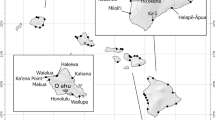
A qualitative review of tsunamis in Hawaiʻi
Scott Fisher, James Goff, … David Sear

Tsunami Early Warning Services
Avoid common mistakes on your manuscript.
1 Introduction
The 2004 Indian Ocean tsunami remains the deadliest tsunami in recorded history. The earthquake, which had a magnitude M w 9.3 and a rupture length of approximately 1200 km ( Stein and Okal 2005, 2007 ), triggered a tsunami that reached 30 m in height ( Synolakis and Kong 2006) and caused at least 230,000 fatalities in 15 African ( Fritz and Borrero 2006 ; Weiss and Bahlburg 2006) and Asian countries, such as Indonesia, Sri Lanka, Thailand, the Maldives ( Borrero et al . 2006; Jaffe et al . 2006 ; Goff et al . 2006 ; Ruangrassamee et al . 2006; Fritz et al . 2006 ; Okal et al . 2006a ), and other island countries in the Indian Ocean ( Okal et al . 2006b , c ). Lessons were learned and good practices were developed as a result of this event. Far-field tsunami hazards from other possible sources were also studied after the 2004 event, focusing on various countries ( Løvholt et al . 2006 ; Burbidge et al . 2008 ; Latief et al . 2008 ; Okal and Synolakis 2008 ; Suppasri et al . 2012a , b ). In addition, disaster risk-reduction elements, such as tsunami early warning systems, evacuation buildings, tsunami memorials, tsunami museums and disaster education programs, were developed in this region. This paper presents a summary of the progress made with regard to disaster preparedness over the last 10 years in Indonesia, the Maldives, Sri Lanka and Thailand based on studies, observations and our collaborative activities with government and international counterparts in Japan. This is somehow representative of efforts made by other nations, including the US, Germany, France, Australia, New Zealand and Chile. The main objectives are as follows: (1) to report on the reconstruction and vulnerabilities after 10 years, (2) to evaluate the present tsunami warning systems and emergency response measures and (3) to discuss disaster awareness in terms of education, memorials and the geological evidence that remains and conveys the risk of tsunami impacts. In considering the first objective, we present a summary of the reconstruction of housing and vital infrastructure and the restoration of businesses, land use and education in the affected countries during the initial years after the disaster. To address the second objective, large earthquakes that have generated ocean-wide tsunami warnings and have impacted the region are evaluated. Finally, to address the third objective, we assess the progress made with regard to disaster preparedness and the future challenges faced in these areas.
2 Early Stage Reconstruction After the 2004 Indian Ocean Tsunami
This section describes several examples of the early-stage reconstruction conducted during the first few years after the 2004 tsunami, including housing, lifeline and business restoration, land use management, disaster reduction education and the internal conflicts.
2.1 Housing Reconstruction
Sri Lanka is used as an example here. The tsunami hit the Eastern, Southern and Western coasts of Sri Lanka 2–3 h after the earthquake, with maximum measured run-up heights from several meters to 10 m or more ( Goff et al . 2006 ). The tsunami killed more than 31,000 people and destroyed 80,000 houses, displacing more than 500,000 people ( Khazai et al. 2006). Housing reconstruction was studied by Murao and Nakazato ( 2010 ), who used data on more than 56,000 transitional houses and 28,000 permanent houses in the tsunami-damaged areas of Sri Lanka. They computed the recovery ratio—the ratio of the number of buildings constructed per month—to the total number of completed buildings as of February 2006, 15 months after the tsunami. Approximately 50 % of the reconstruction was completed after 5 months for the transitional houses and after 8 months for the permanent houses. The transitional houses were constructed mainly during the first period after the tsunami, whereas the construction of permanent houses began after careful evaluation by the government and stakeholders. In Sri Lanka, no-construction zones existed in areas that underwent the rehabilitation process. The reconstruction and the resettlement has been performed considering the initial no-construction zones ( Franco et al . 2013 ) declared as 100 m in the South and West, 200 m in the East, and 500 m in the North. However, these initial no-construction zones obtained opposition from the local community as they created severe constraints on their daily lives and livelihoods, and as a result the buffer zones were revised to 25–50 m in the Southern Districts and a minimum of 50 m on the Eastern coast. Although the 200, 500 and 25–50 m no-construction zones are not arbitrary, broad no-build zones still exist and affect people’s livelihoods.
2.2 Lifeline Infrastructure Reconstruction
A comparative study of lifeline reconstruction between the cases of Okushiri Island, Japan, after the 1993 tsunami and Nam Khem village in Phang Nga province of Thailand was performed by Takada et al . ( 2010 ). They reported that the water and power supply reconstruction in Nam Khem village took approximately 1 and 3 months, respectively, whereas the full recovery of lifelines took 5 years on Okushiri Island. This difference was due to the preference of the local residents of Nam Khem village to rebuild in the same place where they had lived before the tsunami. Therefore, the local residents were able to move into their new permanent houses directly from the evacuation shelter. Conversely, on Okushiri Island, the local residents worked for many years together with the local government to design a new, resilient town to mitigate future disasters.
2.3 Business Restoration
A survey of business restoration was carried out in Galle, Sri Lanka, in 2005 ( Kuwata and Takada 2010 ). Galle, the capital city of Southern Sri Lanka and known as the location where the tsunami swept away a train with almost 2000 passengers, is located on the south tip of Sri Lanka where the tsunami inundation depth measured more than 5 m ( Goff et al . 2006 ). In this study, business restoration was defined by the amount of sales of a product after the tsunami compared to the amount of sales of the same product before the tsunami. The data were obtained through interviews with shop owners. Financial services and lifelines were the two types of businesses that were restored most quickly. These businesses were fully restored after 2 months because both were considered important for the overall reconstruction. Moreover, agricultural restoration took approximately 6 months. Although the farmers may be situated far away from the sea, the agricultural sector took longer time to completely restore as it was necessary to first remove contamination of the soil due to salinity ( Kuwata 2011 ). Tourism, manufacturing and both wholesale and retail businesses were slowly restored; approximately 50 % were restored 6 months after the tsunami. One of the reasons for this was the reduction in visiting international tourists. Fisheries suffered the most; less than 40 % were restored 1 year after the event. Reasons for this include the damage incurred by fishing boats and the rumors of incurring health risks from eating seafood from the area.
2.4 Land Use Management
An example of land use management as an important adaptive strategy for tsunami resilience in the Maldives was presented by Riyaz and Park ( 2010 ). The Maldives is a country that is extremely vulnerable to many types of hazard, i.e., storm surges, torrential monsoon rain, sea level rise, tidal waves and tsunamis. Unlike other countries in the Indian Ocean, the average height of Maldivian islands is 1.5 m above Mean Sea Level which exacerbates the challenges associated with the tsunami evacuation process (Ministry of Environment, Energy and Water 2007 ). Therefore, the “Safer Island Concept” ( Fritz et al . 2006 ) was proposed as follows: (1) establish environmental protection zones (EPZs): high-level sand bunds or embankments to protect the islands from a high rise in sea level, (2) create lower drainage areas on the landward side between the ring road and the EPZ for proper water drainage and (3) build elevated ground or high-rise buildings for vertical evacuation. Vertical evacuation sites can act as a good solution to the problem, but these sites must be built to withstand the great impact, which includes floating debris. The government of the Maldives decided to pursue this concept on ten islands as a long-term goal. However, only two islands have presently been developed as “safer islands”. In addition, the two islands developed as “safer island” do not strictly follow the concept outlined above.
2.5 Disaster Reduction Education
Education is important in addition to reconstruction. Examples of new efforts in disaster reduction education in Thailand, at the government level, and Indonesia, at the local level, are discussed in this section. Siripong ( 2010 ) reported that, in Thailand, three government agencies provide disaster reduction education: (1) the Ministry of Education, for schools and universities, (2) the Department of Disaster Prevention and Mitigation, for operational and rehabilitative academies, and (3) the National Disaster Warning Center. The role of each agency and their collaboration with international organizations are explained in the study. Goto et al . ( 2010 ) introduced an example of educational materials and methods at the local level: a collaborative workshop between Japanese and Indonesian universities. Visual educational aids, such as computer graphic of tsunami, and exercises, such as evacuation drills and the preparation of evacuation maps, were judged to be effective educational tools. Yasuda et al . ( 2014 ) present similar activities in the 2004 tsunami-affected countries (Indonesia and Thailand), the 2011 tsunami-affected area in Japan, and the 2013 Typhoon Haiyan-affected area in the Philippines and Hawaii. They found that after the activity, for example, 20 % of the students changed their mind from agreeing to totally agreeing to tell their parents what they have learned in class.
2.6 Internal Conflicts
There are some examples of internal conflicts associated with the early-stage reconstruction of this tsunami disaster as both Indonesia and Sri Lanka had been affected by civil war for several decades before the tsunami ( Bauman et al ; 2007 ; Enia et al . 2008; Hyndman 2009 ; Kuhn 2009 ). Two of the main issues raised during the early-stage reconstruction are (1) public safety of post-tsunami buffer zone/empowerment issues among the government and rebels, and (2) distribution of aid and goods from international institutions ( Hyndman 2009 ). However, the result of the conflicts after the tsunami is different in both countries. Banda Aceh achieved peace after an agreement in 2005 and greater access of natural resources such as oil and gas even before the tsunami. On the other hand, civil war was renewed in Sri Lanka with the loss of government power. These examples suggest the need to pay more attention to post disaster conflict zones given their potential of both positive and negative ends ( Enia 2008 ).
3 Review of the Indian Ocean Tsunami Events After 2004 and Their Impacts
This section describes the three major tsunamis triggered by earthquakes with magnitudes of approximately M 8.0 or greater and their impacts on countries bordering the Indian Ocean. These three events occurred after the 2004 Indian Ocean tsunami: the 2005 Nias earthquake, the 2007 Sumatra earthquake, the 2010 Mentawai earthquake and the 2012 Indian Ocean earthquakes, as shown in Fig. 1 .
The locations of the major earthquakes in the Indian Ocean since 2004 and the population distribution, revealing the vulnerability of this region. (Original data from Oak Ridge National Laboratory 2006 )
3.1 The 2005 Nias Earthquake and Tsunami
This earthquake occurred on 28 March 2005, 3 months after that of December 2004, with a magnitude of M 8.7 (USGS 2005 ). The earthquake was felt on the entire west coast of Malaysia and in high-rise buildings in Singapore and Thailand, among other countries. The ground motion reached as far as the Andaman Islands, but it was not felt on the Indian mainland (ASC 2005 ). The epicenter was located in a shallow water region, producing a high-intensity earthquake but a small tsunami. Based on field survey data ( Borrero et al . 2011 ), the tsunami runup height was approximately 4 m or less at areas near the epicenter. These values are comparable to those of the 2004 tsunami at the same location. Smaller waves were detected at tide gauges in the Indian Ocean in comparison to the 2004 event shown in brackets: for example, 0.10 m (1.08 m) in Male, the Maldives; 0.13 m (0.30 m) in the Cocos Islands, Australia; and 0.21 m (1.50 m) in Colombo, Sri Lanka (NOAA/NGDC 2014 ). Tsunami warnings were issued by the Pacific Tsunami Warning Center to many countries in the region but were later cancelled. People in Indonesia, India, Malaysia, Sri Lanka and Thailand evacuated to safer places by moving to higher ground, whereas traffic jams occurred on the roads leading out of Banda Aceh, Indonesia, and the coastal areas of Chennai, India (ASC 2005 ). Fatalities were due primarily to the strong ground motion in areas near the epicenter; however, the USGS ( 2005 ) reported that at least ten people died from panic during the evacuation from the Sri Lankan coast.
3.2 The 2007 Sumatra Earthquake and Tsunami
Another large earthquake of magnitude M 8.5 (USGS 2007 ) occurred in this region on 12 September 2007, 3 years after the 2004 event. Similar to the event in 2005, the earthquake was felt in countries as far as Malaysia, Singapore and Thailand, and high-rise buildings were used for evacuation (BBC 2007 ). In addition, tsunami warnings were issued to several countries in and around the Indian Ocean, including small islands and Indonesia, India, Malaysia, Sri Lanka and even Kenya (BBC 2007 ). A moderate tsunami with a runup height of approximately 4 m was measured in the areas near the epicenter ( Borrero et al . 2009 ). Relatively smaller tsunami waves were observed at tide gauges in the Indian Ocean, including 0.40 m in Phuket, Thailand; 0.11 m in Male, the Maldives; 0.12 m in the Cocos Islands, Australia; and 0.30 m in Colombo, Sri Lanka (NOAA/NGDC 2014 ). Although the tsunami caused destructive damage to buildings and facilities, no one was killed due to the successful tsunami evacuation following warning messages that reached residents via TV or radio ( Imamura 2008 ).
3.3 The 2010 Mentawai Earthquake and Tsunami
Although the magnitude of this earthquake (M 7.8) was smaller than the others discussed in this section, the number of casualties was the largest (as high as 509) (NOAA/NGDC 2014 ). In fact, this earthquake was considered a “tsunami earthquake” that generated a much larger tsunami than expected from the seismic magnitude, insofar as the observed tsunami was 4–7 m high ( Tomita et al . 2011 ; Satake et al . 2013 ) and the maximum runup was measured as high as 16.8 m ( Hill et al . 2012 ). Issues that might have magnified the damage and impact include the following: (1) risk bias: the previous large earthquakes generated strong ground motions but did not generate significant tsunami; the slow ground motion during the 2010 earthquake thus brought a false sense of safety, and most people thought that no tsunami would follow ( Muhari and Imamura 2014); (2) the earthquake occurred at night; (3) the earthquake occurred in a location where there was less awareness; and (4) there was no adequate tsunami warning infrastructure to warn the local people. There was no damage reported in the mainland areas where the earthquake was felt, but the tsunami damaged the remote Mentawai Islands, where the tsunami arrived as soon as 5–15 min after the earthquake in some areas. Here, there was also a problem with the tsunami warning systems. Villagers were not given early warning because some buoys had been vandalized, and the equipment had been too expensive to replace (The Telegraph 2010 ). However, some communities, particularly those residing in the northern part of the affected areas—which is famous for its surfing activities—were able to evacuate; the evacuation was possible not because of the warning but because of the surfers’ guidance ( Mikami et al . 2014). Therefore, this event signifies the importance of education for self-evacuation, especially in such remote areas or areas where tsunamis could arrive swiftly. The 2010 tsunami was also observed in other countries, reaching heights of 0.09 m in Colombo, Sri Lanka; 0.11 m in Male, the Maldives; and 0.16 m in the Cocos Islands, Australia (NOAA/NGDC 2014 ).
3.4 The 2012 Indian Ocean Earthquakes and Tsunami
The last two sizable events were both outer-rise earthquakes (an unusual type of earthquake that occurs near oceanic trenches; Geist et al . 2009 ) of magnitudes over M 8.0 that occurred in North Sumatra on 11 April 2012. One of the earthquakes had a magnitude of M 8.6, whereas the second earthquake presented with a magnitude of M 8.2; they were located 100 and 200 km southwest of the major subduction zone (USGS 2012 ), respectively. They were felt in areas as far away as Malaysia, Thailand, India and the Maldives, and tsunami warnings were issued for all countries bordering the Indian Ocean (Aljazeera 2012 ). Residents of Indonesia, Thailand, Sri Lanka and India were advised to move to high ground or to stay far away from the sea. Nevertheless, due to the strike-slip type of these earthquakes, no significant damage was reported in the countries surrounding the Indian Ocean, and the tsunami height was recorded at approximately 0.05 m in Phuket, Thailand; 0.08 m in the Cocos Islands, Australia; 0.21 m in Male, the Maldives; and 1.08 m in the port of Meulaboh, Aceh, Indonesia (NOAA/NGDC 2014 ).
3.5 Return Period of the 2004 Event-Like Earthquake
One important issue is the recurrence of major tsunami such as the 2004 event. Information of the earthquake return period in the Indian Ocean basin can be obtained from the following studies. Burbidge et al . ( 2008 ) derived hazard curves representing the earthquake return period as a function of magnitude in Java, Sumatra, Nankai, Seram and South Chile. The data were mainly based on the earthquake focal mechanisms of all the earthquakes in the Global CMT catalogue for the eastern Indian Ocean region since 1976 with M w ≥ 7.0 and depths less than 100 km. Because records of seismicity are rarely long enough, they proposed their own method developed to avoid underestimating the return period due to infrequent earthquake events in the area. From their proposed hazard curve, it was estimated that a 2004 tsunami-class earthquake might occur every 1000 years.
A similar earthquake return period was shown in a study by Latief et al . ( 2008 ). They considered four main subduction segments as tsunamigenic sources in Aceh-Seumelue-Andaman and Nias. The analysis was conducted using the EZ-FRISK program to provide a hazard curve correlating earthquake return periods and the potential moment magnitudes while considering the seismic parameters adopted in the recurrence models. Their results indicate that the recurrence of an event comparable to the 2004 tsunami is approximately 520 years.
Another method for calculating the earthquake return period was used in an investigation of sand sheets in Phang Nga province, Thailand ( Jankaew et al . 2008 ). From the results of this study, it was concluded that the full-sized predecessor to the 2004 tsunami occurred about 550–700 years ago. The same survey method was conducted in Aceh province, Indonesia ( Monecke et al . 2008 ). They concluded that the recurrence of the 2004 tsunami is about 600 years which agrees with the estimation by Latief et al . ( 2008 ) and Jankaew et al . ( 2008 ). Therefore, approximately 600 years may be considered a suitable number for the return period of the 2004 event such as earthquake. This information is very important for disaster planning and policy-making.
4 The Situation in Indonesia
4.1 overview.
In contrast to Japan, which has a long history of tsunami disasters and has implemented countermeasures, the word “tsunami” was not commonly heard and its impacts were not well understood in Sumatra prior to the 2004 Indian Ocean tsunami, even though there were some major tsunami events prior to the 2004 event such as the 1992 Flores and the 1994 Java tsunamis. The tsunami of 2004 destroyed 120,000 homes and heavily damaged 70,000 more, destroying 3000 government buildings (including hospitals and schools) and 14 seaports. Nearly 3000 km of roads in this region were damaged, and 150,000 people lost their lives. Overall, the tsunami affected 800 km of Indonesia’s coastline, with a total affected area of 413 km 2 ( Samek et al . 2004 ).
Because of the breadth and scale of the disaster, the Indonesian government established a special agency, called the Agency for Reconstruction and Rehabilitation in Aceh and Nias (BRR Aceh-Nias), to conduct reconstruction activities in Banda Aceh and the surrounding areas. This agency began to operate in mid-2005. With only a 4-year tenure, reconstruction activities focused on the development of housing (2005 to mid-2007), the development of public infrastructure (2005–2008), institutional and social development (2005 to mid-2009) and economic development (2005–2009). The agency’s overall reconstruction expenses were 6.7 billion USD, which came from the Indonesian government (37 %), bilateral and multilateral donors (36 %), and national and international non-governmental organizations (27 %).
The redevelopment of the Aceh region was conducted with a community participatory method at the village level. For instance, a community would decide whether its area would be rebuilt using land consolidation or if it would be left as it was. Along with these village-level reconstruction efforts, facilities and infrastructure for future tsunami mitigation were also designed at a higher level. A field visit was organized in November 2014 to observe these facilities as shown in Fig. 2 . Buildings for vertical evacuation are now ready for use in Banda Aceh (Fig. 3 a), and evacuation routes have been tested in national and international tsunami drills, in which all countries affected by the 2004 tsunami performed the drills. Recognizing that experiencing the enormity of a tsunami is important, the media has been employed to disseminate the tsunami-related experiences from 2004 to future generations in various forms. A tsunami museum (Fig. 3 b) was established in Banda Aceh along with 85 tsunami poles that indicate the height of the tsunami that hit the area. Other forms of memorials, such as ships (Fig. 3 c), including a large diesel power plant vessel that was carried approximately 3 km inland, were left in place as a memorial for future generations (Fig. 3 d).
Locations in Banda Aceh, Indonesia mentioned in this study
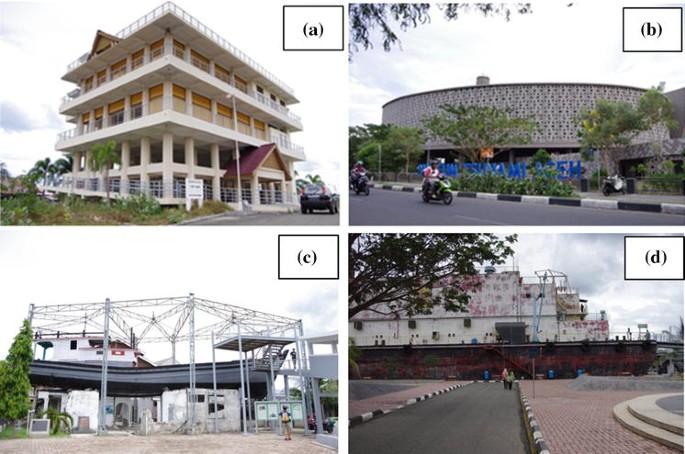
a One of the four vertical evacuation buildings in Banda Aceh, b the tsunami museum in Banda Aceh, with an evacuation sign indicating the entrance, c the memorial site of a stranded ship and d the 2600-ton floating power plant that was swept inland by the tsunami
4.2 Development of Tsunami Early Warning Systems
The development of a tsunami early warning system has been one of the major initiatives in Indonesia since the 2004 Indian Ocean tsunami. It was first developed under cooperation between the Indonesian and German governments in 2005 ( Münch et al . 2011 ; Pariatmono 2012 ). It was launched in 2009 and the present status is reviewed by Lauterjung et al . (2015). Since its development, the system has been tested by both near- and far-field actual tsunamis ( Muhari and Imamura 2014). The primary aim of an early warning system is to disseminate the information that a tsunami might occur after the occurrence of an earthquake; the Indonesian tsunami early warning system (Ina-TEWS) is able to issue a tsunami warning within 5 min after an earthquake ( Pariatmono 2012 ).
Tsunami buoys are not yet integrated in the overall warning system. The buoys are managed by an institution, which is separate from BMKG (Badan Meteorology, Klimatologi dan Geofisika, or the Meteorology, Climatology and Geophysics Agency). The challenge this system faces is not only when the warning is issued but also when the warning should be cancelled. During the 2010 Mentawai earthquake, the warning was terminated 51 min after the earthquake, although the tsunami was still occurring up to 2 h later, particularly in the small bays in the remote Mentawai Islands ( Muhari and Imamura 2014). The decision to terminate the warning was made after considering real-time data from the nearest tide gauges, which indicated the tsunami height was only as high as 0.22 m (in Enggano) prior to the warning’s termination (BMKG 2010). However, those tide gauges were located approximately 300 km away from the source (Fig. 5 ). Near the source, in the southern part of the Mentawai Islands, located only 50 km from the rupture area, the tsunami height was much higher, ranging from 2 m to a maximum of 17 m, as observed on the small Sibigau Island located near South Pagai Island ( Hill et al . 2012 ; Satake et al . 2013 ).
Moreover, during the 2011 Japan tsunami, the tsunami warning in the east Indonesian region was terminated just after the first wave arrived. However, the largest wave came 1 h later and caused the death of a local who had returned to the lowland after receiving notice that the warning had been terminated ( Diposaptono et al . 2013 ). The lack of real-time measurement data for continuously updating the warning level or for indicating whether a tsunami has been generated is one of the issues that needs to be resolved. In addition, disseminating warnings in remote areas, such as small islands, is another challenge for future improvements to the system.
From the perspective of warning dissemination, even though the National Tsunami Warning Center (BMKG) had successfully issued a warning within 5 min after the earthquake, the local sirens did not sound because they relied on the affected city’s electricity, which was usually automatically shut off during the earthquake. Manual activation of the sirens was difficult because the officer in charge of them also evacuated after the earthquake. Such a practical problem should be addressed to ensure safe evacuation in the future.
4.3 Tsunami Evacuation Condition
The other issue is the human response to warnings. The 2012 Indian Ocean earthquake was likely the best opportunity to test the preparedness of the people of Banda Aceh against tsunamis. The magnitude M 8.6 earthquake triggered a massive evacuation even though the tsunami sirens in Banda Aceh did not sound until 70 min after the initial shock. Most of the people evacuated using motorcycles to quickly escape the lowland area. Although vertical evacuation buildings were available in the lowland, most of the residents did not believe that the structures could withstand the earthquake and tsunami. The majority of people in Banda Aceh thought that horizontal evacuation was the best choice. As a result, massive traffic jams were observed along the main road of Banda Aceh City during the evacuation. According to a survey conducted after the event ( Goto et al . 2012c ) among 161 people who evacuated (of the total 220 respondents), 153 were trapped in the traffic jam during the evacuation. Respondents did not believe that the vertical evacuation structures could increase their chances of successfully evacuating given the limited time before the tsunami would arrive. The lack of community participation in determining the location and design of the vertical evacuation structures is believed to be one of the reasons why, even now, people do not trust that vertical evacuation structures can save their lives. In addition, the lack of interest in these structures has led to poor maintenance of the facilities (Fig. 4 ), which are rarely used, even for social activities, by the residents who live near the buildings.

a A wooden bar blocking the entrance for disabled persons to the evacuation building and b the first floor of the evacuation building
Banda Aceh city has made several plans to reduce the problem of traffic jams during emergency situations to facilitate evacuation of future disaster. Tsunami evacuation simulation was conducted ( Goto et al . 2012b ) and some plans have been realized such as widening existing roads which are to act as escape roads, and also making emergency crossings on two-way main roads. This emergency crossing will be used in emergency situations to shorten U-turns or to cut the road block so that traffic jams can be avoided or reduced. Another plan to be implemented in 2015 is to make a flyover on roads with heavy traffic and to also make an underpass on the designated road that has been identified by the city government. With support from the National Agency for Disaster Management (BNPB) Banda Aceh city has made a tsunami evacuation road map. This tsunami evacuation road map should be publicized to Banda Aceh city residents to facilitate proper evacuation for future disaster mitigation.
4.4 Design of Evacuation Buildings
An evacuation building in Banda Aceh has been designed with four stories and an overall height of 18 m, and incorporates 54 columns each having a diameter of 70 cm. The roof includes a helipad for helicopter landings. In a large-scale tsunami evacuation drill which was held on 2 November 2008, a helicopter was landed there smoothly. The second floor has a height of approximately 10 m, as indicated by the 26 December 2004 tsunami wave height at the location of the building. The first floor is left open with no partitions or hollow structures, following the concept of the mosque. The aim is to avoid the wave force of future tsunamis. The building can accommodate the evacuation of 500 people and is designed to withstand earthquakes with a moment magnitude of 10 on the Richter scale. The stairs leading to the upper floor is made of two parts. One main staircase has a width of approximately 2 m and another one has a width of 1 m with the slope designed to accommodate the use of wheel chairs in emergency situations. The building is also equipped with facilities for emergency situations. The building serves as a community center that is surrounded by villagers who are alert and ready to mitigate the effects of disasters.
5 The Situation in Sri Lanka
The 2004 Indian Ocean tsunami is remembered as the most devastating catastrophe in Sri Lanka, having caused 35,000 fatalities on two-thirds of the coastal belt, across 13 coastal districts (ADB 2005 ). The waves penetrated approximately 500 m inland, on average, to a maximum of 2 km on the east coast and with a maximum tsunami runup recorded on the southern coast over 10 m in Yala ( Liu et al . 2005 ) and Hambantota ( Wijetunge 2009 ). The damage in Sri Lanka was particularly severe along the coast from east to south. The damage was dramatically more significant because no tsunami early warning system existed in Sri Lanka at the time due to the country being located very far from active faults.
Since the 2004 event, several individuals and national and international organizations have supported the recovery of the damaged areas on a short-term and long-term basis. Providing food, clothing and temporary shelter to displaced populations comprised some of the immediate actions taken by authorities. Resettlement and reconstruction activities supervised by the Ministry of Relief, Rehabilitation and Reconstruction commenced after the completion of the relief activities (ADB 2005 ). Reconstruction activities were further enhanced by short-term and long-term plans that led to the establishment of a powerful body called the Disaster Management Center (DMC) in 2005. However, there have been many challenges regarding the policy to create urban development strong enough to withstand future disasters. The 2004 tsunami itself created the unforgettable example of a lack of awareness of tsunami events leading to devastating damage in Sri Lanka even though it was a far-field tsunami. This occurred, in part, because there are still very few tsunami experts in Sri Lanka; consequently, hazard and risk evaluations have been insufficient. Our group monitored the recovery process in Sri Lanka from 2010 to 2013 with the cooperation of the Japan International Cooperation Agency and the Miyagi Prefecture in Japan. Here, we briefly summarize our work and discuss the current problems related to the recovery process and to future tsunami countermeasures in Sri Lanka.
5.1 The Current Conditions of Severely Damaged Areas
Galle City was severely damaged by the 2004 Indian Ocean tsunami (Fig. 5 ). The tsunami runup height in this city was estimated at 4–5 m ( Liu et al . 2005 ; Wijetunge 2009 ). The placement of tsunami signs, the designation of hazard zones and disaster prevention education activities have been conducted by city authorities, universities and schools. A group from the Faculty of Engineering at the University of Ruhuna in Sri Lanka prepared a tsunami hazard map and evacuation plan for Galle City following the guidelines that were being used in Japan (Coastal Development Institute of Technology 2004), and this was one of the initial activities that led to increasing people’s tsunami awareness ( Wijayaratna et al . 2006 ). However, it is difficult to continue disaster-prevention activities with a limited budget and changing levels of awareness of tsunamis in the local population. This problem is likely to be widespread among tsunami-affected countries. Consequently, it is important to determine how to continue disaster-prevention activities over the long term. For example, there is a Tsunami Photo Museum in Telwatta containing thousands of photographs taken during and after the tsunami as well as paintings by children. However, the museum is operated by the private sector, so it is important to determine how to continue to support such a museum. According to the DMC, the establishment of a disaster information system has been completed. However, the hazard map for various types of natural disasters and the action agenda for disaster prevention require improvement.
Locations of coastal cities in Sri Lanka mentioned in this study
Hambantota and Yala are other locations on the southern coast that were severely affected by the Indian Ocean tsunami ( Liu et al . 2005 ; Goff et al . 2006 ). Being mostly flatland, Hambantota City was affected by the tsunami, and a lack of awareness by its people increased the damage it experienced. During our 2012 visit to Sri Lanka, we were able to visit Yala, where many casualties were reported, including 15 foreigners. A safari tour guide from Yala who was a witness to the Indian Ocean tsunami stated that the tsunami flow that came through the lower lands was strong enough to kill the people who were on the safari tour even though the Yala area is covered by sand dunes. He further emphasized that most of the animals in the Yala wild park were safe and that people died because of their lack of awareness of the event. In addition to localized reconstructions and developments, the DMC was able to create a well-planned early warning system for disasters, including 74 early warning towers that cover the entire coastal belt of Sri Lanka; the aim of these towers is to issue tsunami and storm surge warnings.
5.2 The Recovery of Harbor Functions
The damage the Indian Ocean tsunami caused to coastal infrastructure, ecosystems and the fishery sector was significant. Nearly 80 % of fishing boats and ten out of the twelve fishery harbors were badly damaged (CH2MHill 2006 ). Hikkaduwa, Mirissa, Galle, Puranawella, Hambantota and Kirinda are harbors that were considered highly damaged due to the tsunami. The Kirinda fishery harbor is a good example of engineering projects that mitigate natural phenomena. After its initial construction, the harbor faced a serious problem in 1992: sand accumulation blocked the harbor entrance. Some civil engineering projects, such as dredging and the construction of new breakwaters, were introduced to solve the problem, but the problem continued until before the 2004 tsunami occurred (Fig. 6 ). The Kirinda fishery harbor was severely affected by the 2004 Indian Ocean tsunami in terms of both coastal structures and coastal morphology (e.g., Goto et al . 2011 ; Ranasinghe et al . 2013 ). During the tsunami, an approximately 8-m-high tsunami flood was recorded, and a large dredging ship called the Weligowwa was cast ashore. Because of the sand blockage, bathymetric change was being measured in detail at regular intervals. The last measurement before the tsunami was taken in November 2004. Post-tsunami bathymetry was measured from February to March 2005. According to Goto et al . ( 2011 ) and Ranasinghe et al . ( 2013 ), the first runup tsunami wave transported large amounts of offshore, sea bottom sediment and deposited it in a layer up to 4 m thick along the shoreface slope. Bathymetry values returned to normal by November 2005, approximately 1 year after the tsunami. After the tsunami, sand accumulation began again, and sand blockage had re-occurred by 2006. Because the harbor was an important facility for fishermen, dredging work has been conducted such that, as of 2013, the harbor is in use.
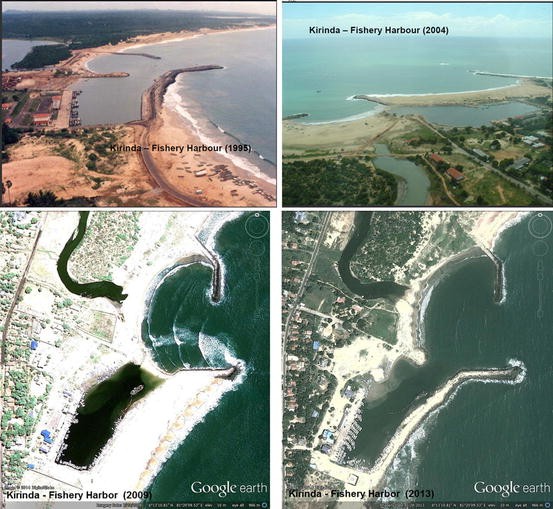
Bathymetric changes in the Kirinda fishery harbor in 1995, 2004, 2009 and 2013. [Image source: Lanka Hydraulic Institute Ltd (LHI) and Google earth]
In the case of Kirinda, the tsunami’s impact on bathymetry was limited, and it recovered very quickly. However, several studies have reported that coastal geomorphology has not fully recovered from the 2011 Tohoku-oki tsunami ( Udo et al . 2013 ). It is very important that we understand what determines whether coastal geomorphology recovers.
5.3 Scientific and Technological Support from Japan
In this project, the Japan International Cooperation Agency (JICA) led a collaboration with the Miyagi prefectural government and Tohoku University. The project was implemented for 3 years in 2009, 2010 and 2012. To expand the understanding of city planning in preparation for future disasters in Sri Lanka, Japanese knowledge of disaster-prevention-specific activities in the region was taught to trainees from Sri Lanka. The goals were the comprehensive support and practice of science and technology, the practice of disaster prevention, enlightenment and education. During their training in Japan, trainees learned basic disaster prevention, disaster history and the primary countermeasures and current challenges in both countries. The trainees are expected to contribute to disaster prevention and mitigation activities in Sri Lanka. In addition, education on earthquake and tsunami disaster prevention assistance in Sri Lanka was provided through seminars and workshops, the presentation and sharing of information, the exchange of ideas and the presentation of challenges. A tsunami deposit site visit to assess the risk of low frequency hazards will also be required in the future. In addition, disaster prevention education, awareness-raising activities and community-based disaster management activities in schools and the education community, based on the Participatory Technology Assessment (PTA), were organized with local professionals. Some examples of our activities, such as a field survey of reconstruction conditions and disaster risk reduction activities are shown in Fig. 7 .
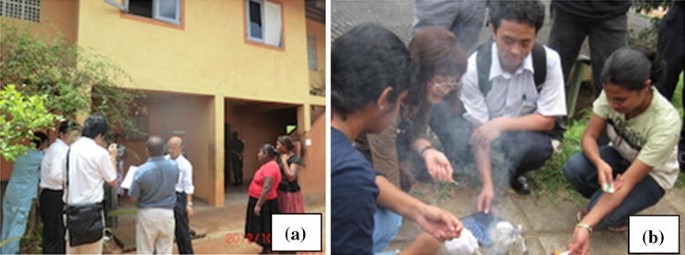
Interviews on disaster response and recovery conditions in Galle City and practicing survival (making rice using cans)
5.4 Problems with Preserving Monuments
Unlike Indonesia and Thailand, Sri Lanka does not have a damaged structure that has been preserved as a tsunami monument. One possible monument is a train named “the queen of the sea” that was hit by the 2004 tsunami with more than 1700 passengers aboard; they became casualties due to their belief that the train would be strong enough to withstand the tsunami. This became the deadliest train disaster in recorded history. Nevertheless, this train might be too emotionally difficult for the local people to preserve as a monument. This example demonstrates the importance of disaster risk education for local people. Among the tsunami memorials that were constructed, the memorial at Peraliya in the Galle district is still in good condition and has become an attraction for tourists as well. This memorial was constructed in remembrance of the people who died in the train accident. The remaining cars of the damaged train had been kept in Peraliya but were then moved to Hikkaduwa and kept there for some time. The train was repaired and put into service, and it ran the same trip on 26 December 2008 as a memorial to the people who lost their lives. In Yala, a resort hotel and most of the vegetation were severely damaged by the tsunami ( Goff et al . 2006 ). After this disaster, the remnants of the bungalow were preserved, and a tsunami monument was constructed in 2005. However, as seen in Fig. 8 , part of the painted writing on the monument disappeared in 2012, and it is difficult to read the text. Although it is very important to memorialize the tsunami disaster by visiting the monument, its preservation is even more important.
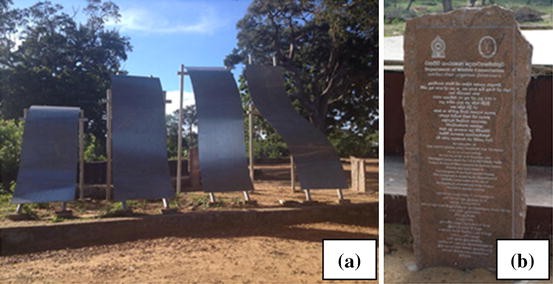
a A steel monument and b a tsunami memorial in 2005 at the Yala safari bungalow
6 The Situation in Thailand
6.1 general observations and future challenges in each location.
A significant change in Thailand after the 2004 tsunami was the establishment of the National Disaster Warning Center (NDWC). The NDWC obtains disaster observation data from the Thai Meteorological Department (TMD) and other international organizations and acts as the center for disaster warning in Thailand. Using this system, a tsunami warning can be issued in Thailand within 5 min after an earthquake occurs. In the six provinces that were damaged by the 2004 tsunami, there are also many examples of change, such as the preparation of tsunami hazard maps and tsunami signs and the construction of tsunami evacuation buildings. Field visits were organized in 2009 and 2013 in areas shown in Fig. 9 in collaboration with the TMD, the NDWC, the Department of Disaster Prevention and Mitigation (DDPM) and the Regional Integrated Multi-Hazard Early Warning System for Africa and Asia (RIMES).
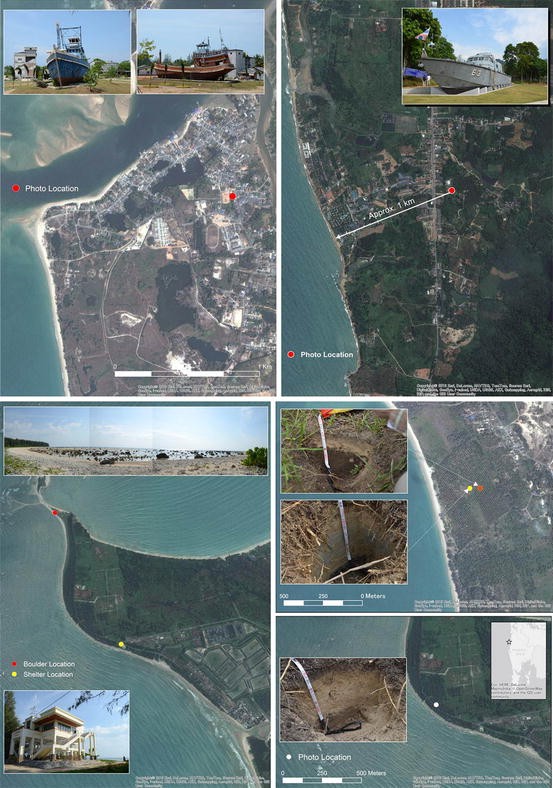
Locations in Phang Nga and Phuket, Thailand mentioned in this study
6.1.1 Nam Khem Village, Phang Nga Province
Nam Khem was one of the worst-hit areas in Thailand, where more than a thousand lives were lost as a result of flooding by a 10-m-high tsunami wave. Most villagers were fishermen or worked in aquaculture and sightseeing. A tsunami museum and memorial were constructed near the coast, containing pictures, damage information and a list of the victims. Another tsunami memorial was made out of two large fishery boats that were transported inland by the tsunami, killing people and destroying houses. The population in Nam Khem village has since decreased, and the tsunami evacuation plan has been very much improved. A number of activities such as tsunami evacuation drills, reconstruction forums, and disaster-related lectures are being conducted here, and residents are well-prepared and highly aware compared to other areas. They have their own tsunami evacuation drills and emergency plans. A sea observation team will check on the receding wave when they receive a warning. This procedure is risky and dangerous because it is not necessarily the case that a tsunami will be preceded by drawdown ( Suppasri 2010 ). Education regarding to the correct basic understanding of tsunamis is still needed. A patrol team will monitor residents’ property. A traffic team will implement their own rules during evacuation, having pedestrians keep left and vehicles keep right. A rescue team will check every house for remaining and possibly disabled residents. A nursing team will provide first aid. The school was moved further from the sea and to higher ground as a result of previous experience. The evacuation route for vehicles is the main road (a 2-lane road). Two types of evacuation drills are conducted, and the residents understand the problems that occur when they have to evacuate in the rain or during nighttime. As a result, their evacuation process in response to the tsunami event on 11 April 2012 was a complete success, without any problems or traffic jams. Nam Khem serves as a good example of a tsunami disaster-resilient community. In 2013, the tsunami memorial park looks similar to what was observed in 2009; however, the two fishing boat memorials (Fig. 10 a) have been seriously deteriorated by corrosion due to a lack of maintenance. In addition, tsunami-related signs, such as hazard maps, tsunami height indicators and evacuation direction signs, have faded due to sunlight and other weathering processes (Fig. 10 b).
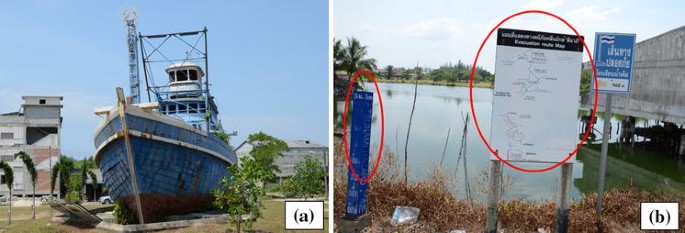
a Corrosion of a memorial fishing boat and b poor maintenance of tsunami-related signs in Nam Khem village
6.1.2 Pakarang Cape, Phang Nga Province
The tsunami evacuation building in Pakarang Cape (Fig. 11 a) is adjacent to the beach, in compliance with the safe zone distance of more than 1 km, and there is no greenbelt to dissipate tsunami energy. Construction began for the evacuation shelter in March 2009 and was completed in November 2009. There is a sign there that indicates the 2004 tsunami level of 5 m, but the actual height of the sign is approximately 1 m. In this area, local residents find a height of 5 m difficult to imagine ( Suppasri 2010 ). This may lead to an underestimation of the tsunami hazard. Therefore, the height of the sign should be set equal to the height of the tsunami. A detailed study of tsunami evacuation simulation in this area, including the mentioned evacuation building, can be seen from a study by Mas et al . ( 2015 -the same issue).
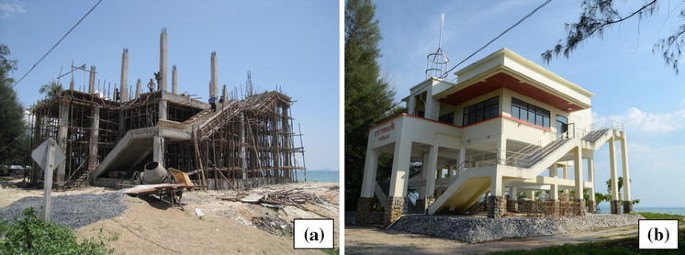
Tsunami evacuation building in Pakarang Cape ( a ) during construction in 2009 and ( b ) in 2013
6.1.3 Khao Lak Area, Phang Nga Province
Khao Lak is the most popular tourist area in the Phang Nga province, where a large number of non-Thai tourists were killed by the tsunami. Many hotels and resorts were also destroyed by the tsunami but had been fully reconstructed a few years after the tsunami. When the tsunami occurred, the water police patrol boat T.813 was on its way to secure one of the royal families and was swept inland across the main road, which is located approximately 2 km from the sea. Some of the boat’s crew, including the captain, survived. The boat is now preserved as a tsunami memorial similar to those in Nam Khem village. Tsunami evacuation signs in both Thai and English were erected in many places in Khao Lak to maintain tsunami awareness. Figure 12 a shows the undeveloped area containing the boat memorial with a wooden bridge crossing the river in 2009. By 2013 (Fig. 12 b), the bridge structure had become concrete, and the area near the boat had been developed and now contains a memorial park, exhibition hall, travel center and other activity spaces.
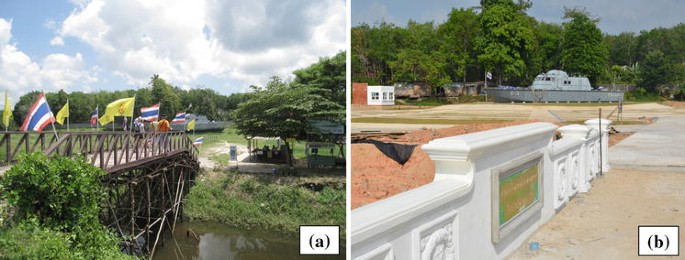
The T.813 patrol boat as a tsunami memorial ( a ) in 2009 and ( b ) in 2013
6.1.4 Patong Beach, Phuket Province
Patong Beach is one of the most popular tourist areas in Phuket and contains many hotels, shops and restaurants. The tsunami in 2004 was not as high there as in Phang Nga. Therefore, only the first floors of buildings were damaged, and the tsunami only reached approximately 300 m inland. There are also a large number of tsunami signs in Patong. Large numbers of tourists stay in the tsunami hazard zone or spend most of their time there. Although evacuation signs are located every 300, 200 and 100 m from the beach to the safe zone, some of them are not well maintained. Moreover, the evacuation route planned by the local government goes through private property and is full of shops and stalls that could lead to a difficult evacuation. The traffic jam in Patong was the most serious among the 2004 tsunami-affected areas. Traffic jams occur daily during rush hour in the morning and evening. One reason for these traffic jams is the large number of motorcycles that are rented by tourists. The three evacuation shelters comprise a school, a temple and a market. All of these shelters are located more than 1 km from the sea. The school appears to be the most suitable shelter because of its space and accessibility. The tsunami warning in 2012 (without a damaging tsunami) confirmed that this situation is very hazardous. The warning occurred during the peak traffic period. As a result, all traffic was at a standstill from the top of the mountain to the road along the beach, inside the 2004 tsunami inundation zone. Figures 13 and 14 show the one-way traffic routes in Patong beach, which extend in a clockwise direction, going north along the shoreline and south on the inner road. Most of the small roads that link these two roads extend toward the sea except for one road that extends inland. The direction of these small roads is one of the reasons for the traffic jam, and the traffic rules during tsunami evacuations in Patong must be improved in preparation for future tsunamis.
Map of Patong beach; the 2004 tsunami inundation depth ( blue ), buildings ( gray ), roads ( red ) and one-way traffic routes ( arrows )

Traffic direction in Patong beach ( a ) in the south and ( b ) in the north
6.2 Geological and Environmental Changes
6.2.1 tsunami boulders at pakarang cape.
The tsunami in 2004 transported thousands of meters-long boulders shoreward at Pakarang Cape, Thailand. Goto et al . ( 2007 ) investigated the size, position and long-axis orientation of 467 boulders on the cape. Most of the boulders found on the cape were well rounded, ellipsoid and without sharp, broken edges. They were fragments of reef rocks, and their sizes were estimated to be an average of 14 m 3 (22.7 t). Goto et al . ( 2007 ) calculated the tsunami inundation at Pakarang Cape. They suggested that the tsunami waves, which were directed eastward, struck both reef rocks and coral colonies that were originally located on the shallow sea bottom near the reef edge; these detached, and the boulders were transported shoreward. During our visit in February 2013 (Fig. 15 a), the boulders were still there. Conversely, sand accumulation was remarkable on the tidal bench, and the beach berm had quickly recovered.

Remaining geological evidence at Pakarang Cape, a tsunami boulders and b tsunami sand deposits
6.2.2 Tsunami Deposits in Bang Sak Beach
Jankaew et al . ( 2008 ) was the first group who discovered paleo-tsunami deposits prior to the 2004 event in Thailand. Although after a decade, there are well-preserved 2004 tsunami deposits on Bang Sak Beach. This area includes a beach and shallow marine sediments with abundant marine plankton. Goto et al . ( 2012a ) conducted field surveys in March 2005 and December 2008 in southwestern Thailand to investigate local variation in the thickness and the preservation potential of onshore deposits formed by the 2004 tsunami. The 2008 survey results revealed that the thickness of deposits varied by a few centimeters in pits located less than 10 m apart because of the local undulation of the topography and possible bioturbation. At 13 of the 24 sites, the difference in thickness between the 2005 and 2008 surveys was within the range of local variation. In fact, very thin tsunami deposits (1 cm thick) in the 2005 survey were well preserved during the 2008 survey. Furthermore, tsunami deposits near the maximum inundation limit were found in the 2008 survey, with thicknesses that were consistent with those reported in the 2005 survey. At no site was a tsunami deposit eliminated completely. Based on these observations, Goto et al . ( 2012a ) inferred that tsunami deposits tend to be well preserved, even in a tropical climate with heavy rains, such as that of Thailand. Our visit in 2013 further supports the observation by Goto et al . ( 2012a ), insofar as we observed that the deposits were well preserved in cases where there were no human disturbances (Fig. 12 b).
6.2.3 Mangrove Forests at Pakarang Cape
Yanagisawa et al . ( 2009 ) investigated the damage to mangroves caused by the 2004 tsunami at Pakarang Cape. Comparing pre- and post-tsunami satellite imagery of the study area, they found that approximately 70 % of the mangrove forest was destroyed by the tsunami. Based on field observations, they determined that the survival rate of mangroves increased with increasing stem diameter. Specifically, they found that 72 % of Rhizophora trees with a 25–30 cm stem diameter survived the tsunami impact, whereas only 19 % of the trees with a 15–20 cm stem diameter survived. After the tsunami, the mangrove forest was not replanted, and parts of the forest became resort areas.
7 The Situation in the Maldives
In comparison to other countries, such as Indonesia, Sri Lanka and Thailand, the Maldives experienced less damage not only because of their geological setting but mainly because of their geological features: the coral atolls with small islands separated by deep channels ( Fritz et al . 2006). Even though the tsunami arrived 4 h after the Maldives, a 9 m runup resulted in 300 fatalities in Somalia ( Fritz and Borrero 2006 ). However, if we compare the displaced population with the total population of the Maldives, the damage was very significant. Although the elevation of the entire island chain is lower than 2 m, the 26 December tsunami had a limited impact on the Maldives due to its unique geological features as mentioned earlier. In addition, because of the country’s low elevation, the tsunami could completely overtop or submerge the island. Therefore, there was no runup process amplifying the tsunami as high as 8 m in Sri Lanka ( Liu et al . 2005 ) and the maximum tsunami height observed in the Maldives was only up to 4.1 m ( Fritz et al . 2006 ). A field visit to discuss the present countermeasures prepared by the central and local governments and to observe the present condition of the Maldives was held from 23 to 29 December 2013 with support from the Asian Disaster Reduction Center (ADRC).
7.1 General Observations
Male, the capital city (Fig. 16 ), with an area of 1 × 2 km 2 , was the main target area for our official visits. The city was protected during the 1990s by seawalls and breakwaters (Fig. 17 a) that were built before the 2004 tsunami; however, measures for supporting evacuation during future tsunamis were not observed. Unlike in Indonesia, Sri Lanka and Thailand, there were no tsunami-related signs to provide information on the tsunami hazard zone, the tsunami height, evacuation routes or evacuation buildings. On the 9-year anniversary of the tsunami (26 December 2013), there were no major events in Male except several news reports, but there were some small events on other islands. There was no sign indicating the tsunami memorial monument shown in Fig. 17 b. This picture was taken on the anniversary, and the monument was no busier than on other days. The main road along the shoreline, which links the entire city, is a one-way street, similar to the roads in Patong beach in Phuket, Thailand. The two-lane road is always crowded with parked cars and motorcycles that could obstruct evacuation (Fig. 18 a, b). The small streets that link the main road to the inland are narrow and obstructed by many objects on the ground. In addition, although most buildings along the shoreline have at least two stories, there are no signs indicating tsunami evacuation shelters. The coast guard building and other government buildings near the shoreline could be used as evacuation buildings.
Locations of atolls and islands in the Maldives mentioned in this study
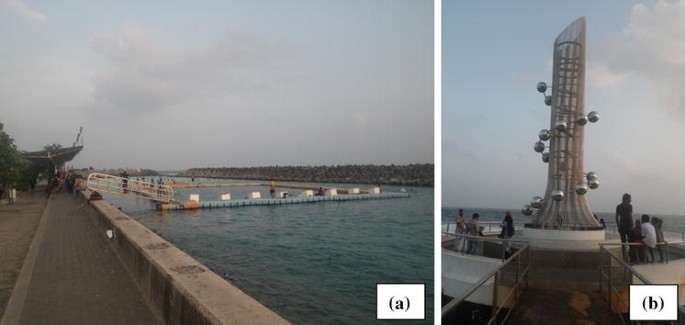
a Seawall and breakwater in the south of Male and b memorial statue of the 2004 Indian Ocean tsunami in Male
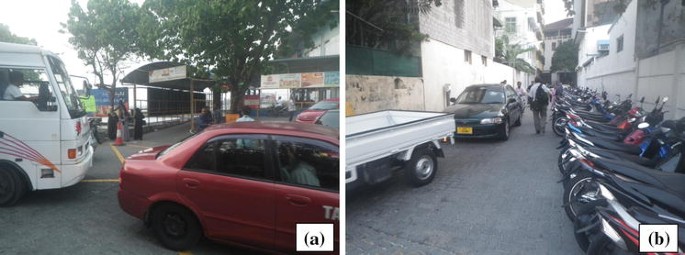
a Crowded traffic during rush hour in the road along the coast and b an evacuation route that is blocked by parked motorcycles
7.2 Central Government Offices
Meetings with several offices of the central governmental were conducted to investigate the ongoing disaster risk reduction efforts of each organization—namely, the Maldives National Defense Force (MNDF), the Ministry of Education (ME), the Ministry of Tourism (MT), the Ministry of Housing and Infrastructure (MHI) and the Maldives Meteorological Service (MMS).
The MNDF is the most important of these agencies because it has the necessary manpower and facilities that can be used during an emergency. It would be one of the first teams to reach the affected areas to solve physical problems and support further activities. However, some of its assets that can be used in case of emergency, such as speed boats, seaplanes and helicopters, will encounter logistical problems because the country contains numerous islands and a limited budget for new assets. Response time is likely the most important factor in an emergency. The shorter the response time of the MNDF it, the more time that is available for other activities, such as the medical team response, the receipt of supporting materials and volunteer work.
The ME is now attempting to implement a disaster-related curriculum in schools starting at the kindergarten level because children may have to lead adults to evacuate in future disasters. For example, during the 2004 tsunami in Thailand, a young British girl helped more than a hundred people evacuate and survive. The ministry is also adapting the teaching materials so that they will be interesting to children.
At present, good practices have been integrated into tourism—i.e., a brief introduction to disaster-related information is provided at check-in at each resort. The MT considers the total exposed population (the local population plus the number of tourists) to be sustainable. Because tourism is the main economic sector in the country, the MT is now addressing any type of disaster that might interrupt tourism activities. Information related to disasters should also be well disseminated because tourists are more sensitive to the media, which mainly focus on bad news.
The MHI is the key ministry for long-term reconstruction insofar as its work is related to daily life. Some problems identified during the interview were (1) the lack of logistics for importing construction resources from nearby countries (e.g., India or the Middle East), (2) the lack of skilled manpower, (3) the necessity of group relocation to reduce construction costs for basic infrastructure and (4) the necessity of providing education to people who receive compensatory money but who spend it to meet different objectives. To solve one of these problems, the MHI is now encouraging children to relocate to bigger islands for a better education. If this occurs, parents must follow their children, and infrastructure construction costs can be reduced.
Although the MMS does not have its own warning system and must rely on other international services, the present warning and observation systems appear to be sufficient. In terms of tsunami warning, the MMS has a network linked to all four major institutions that take measurements in the Indian Ocean. Warning information from these institutions, such as the expected tsunami arrival time and amplitude, is sufficient for such short-term measures; however, for the long term, more detailed information, such as hazard maps for predicted future events, may be necessary. The warning dissemination method still appears to pose problems. A communication network and a commitment to use it during a disaster should be established to disseminate vital information, which should be made more easily understandable for less educated people.
7.3 Relocated Residents and Local Stakeholders
A field site visit was organized to observe and interview local residents and stakeholders. Thulusdhoo Island, the capital of the Kaafu Atoll, was selected as the target area because of its large proportion of relocated residents from other islands affected by the 2004 tsunami—340 out of the total population of 1361 on the island. The island is approximately 25 km northeast of Male. Typical disasters in Thulusdhoo Island are storm surges, floods and coastal erosion; however, the island was hit by waves 1–2 m high during the 2004 tsunami. After the tsunami, the government requested that some companies move off the island, and the factories were used as temporary shelters for 4 years. Figure 19 a shows that the deserted areas remained the same for 9 years. New houses were constructed with donations from Saudi Arabia to those who used to own land before the tsunami, as shown in Fig. 19 b.
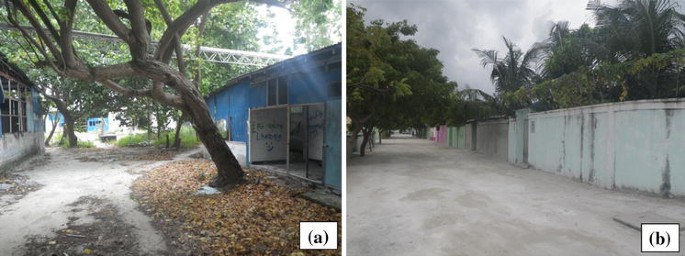
The present conditions of a deserted temporary shelters and b reconstructed houses in Thulusdhoo Island
The island is small, and the sea is a 5–10 min walk from the center of the island. There is only one reinforced concrete high-rise building (Fig. 20 a) for tsunami evacuation on the island, which belongs to the MNDF. This building has speakers on the roof to issue warnings. During the day of our visit, we attended a disaster resilience workshop held by the MNDF in this building. Participants were asked to create an exposure map, a hazard map and an evacuation map for each type of hazard (Fig. 20 b). Residents on this island appear to have a high awareness of disasters as a result of the 2004 tsunami.
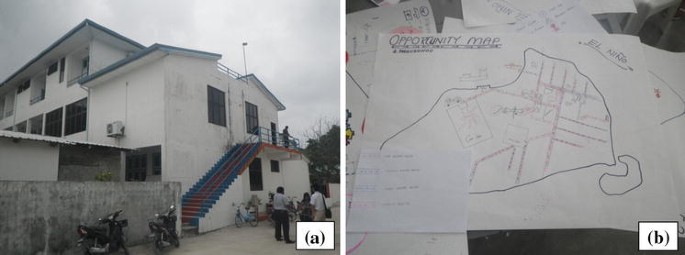
a The MNDF building and b an example of a tsunami evacuation route map made by residents in Thulusdhoo Island
Interviews were organized with the local residents who lost their houses in the 2004 Indian Ocean tsunami and relocated to Thulusdhoo Island. The government gave them a choice of three possible islands for their relocation. All of the residents are satisfied with their new homes, and they have better economic opportunities. Although 9 years have passed since the 2004 tsunami, residents still have a high awareness and a strong will to participate in disaster-related activities. However, there has been a problem regarding the amount of space in residents’ new houses. Because extended families commonly live together in this country, often one house with three rooms cannot accommodate the size of a household.
A meeting was organized with representatives from schools, health centers, the police force and the atoll council. Although the local people are satisfied with the present conditions, the stakeholders who attended the meeting are not because the facilities and infrastructure do not meet the standards to which the government had committed itself. The population size has been increasing, but the capacity of institutions such as schools and health centers has remained the same. In particular, the stakeholders indicated the need to upgrade the health center to a hospital. At the moment, there is still a lack of necessary medical equipment. These problems resemble those experienced in the areas mentioned in the previous section, where the country’s geography makes it difficult for the central government to reach remote areas and provide support.
8 Conclusion
Based on the findings obtained during our visits to the target countries, we identified the three key issues that reflect the preparedness of these areas and the future challenges that exist 10 years after the 2004 Indian Ocean tsunami. For this long interval event, it is necessary to prepare resilient communities for future generations monitoring such progress. In addition, the progress achieved in disaster preparedness after 3 years of reconstruction was compared to that achieved after 10 years and evaluated based on experience in disaster reconstruction in Japan.
8.1 Town Reconstruction and Land Use Planning
The countries in our study area were similar in terms of the installation of tsunami warning signs and the construction of tsunami evacuation shelters, which were constructed while town reconstruction was occurring. In general, the town reconstructions in most of the countries in our study were completed within a few years after the 2004 tsunami, except in the Maldives, where the logistics of obtaining building materials appeared to be the most important factor causing the delay. Improving the logistics system for a country that contains many islands is a challenge. In addition, the country contains a large number of small islands on coral atolls without building materials apart from the corals. In terms of land use planning, there have been no major changes in the popular sightseeing areas, such as those in Thailand and the Maldives. However, future disaster-related property loss is expected to be larger than that from the 2004 event along the Andaman coast of Thailand because that area is more exposed due to the larger number of hotels and resorts. In addition, serious traffic jams might occur similar to those experienced in 2012. For tourism-designated islands in the Maldives, where the number of tourists is significant, taking into account the expected number of tourists appears to be one of the most important measures for emergency response.
8.2 Warning Systems and Emergency Response
Tsunami warning services can be classified into three categories: (1) a regional service (Indonesia), (2) a national service (Thailand) and (3) the need for information from other regional service countries (the Maldives and Sri Lanka). After the 2004 tsunami, the Pacific Tsunami Warning Center (PTWC) acted as the center for tsunami warnings in the Indian Ocean for several years, but currently, this service is being provided by regional tsunami service providers in Australia, India and Indonesia and by other regional services, such as RIMES. Thailand has a national service provided by the NDWC. Sri Lanka and the Maldives do not have their own services, but they receive warning messages from the aforementioned regional service countries. This approach appears to be sufficient in terms of tsunami evacuation. A tsunami evacuation drill is performed yearly and simultaneously in all study areas to test their tsunami warning systems. Nevertheless, further research and development of tsunami-related topics, such as land use planning in preparation for future tsunamis using detailed probabilistic tsunami hazard maps and vulnerability functions, are needed.
8.3 Disaster Reduction Education and Other Disaster-Awareness-Related Topics
Disaster reduction education is an issue to which all countries in our study area gave considerable attention during the beginning stages of reconstruction. Basic knowledge of disasters was added to school curricula, and workshops and lectures were organized in cooperation with both national and international organizations. These efforts will help local people understand the meaning of warnings and the proper action to take during an evacuation. Furthermore, tsunami museums and tsunami memorials have been built in most locations. There are some differences among the countries; for example, Indonesia and Thailand succeeded in maintaining some marine vessels that were carried ashore as memorials, but this was not the case for the damaged train in Sri Lanka. Nevertheless, these attempts will help maintain awareness of the 2004 disaster. Geological evidence will also maintain people’s awareness. The number of boulders that remains in Thailand is a good example for telling the story of the 2004 tsunami.
8.4 Evaluation of the 2004 Affected Countries Using the Four Main Components of Disaster Reconstruction
We further evaluated reconstruction after the 2004 Indian Ocean tsunami based on observations from our field visits using the four main components of disaster reconstruction [Disaster Prevention Research Institute (DPRI) 2004 ]. This type of long-term reconstruction plan is based on experience with historical disasters in Japan, including the 1611 Keicho-Sanriku tsunami and the 1854 Ansei-Nankai tsunami. The four components are described below.
Town reconstruction and planning (Living): town and regional planning conducted alongside housing reconstruction.
Self-reliance and linkage (Communication): communication during normal and emergency periods among local residents, their self-reliance, the linkages among them and evacuation drills.
Community and local industry formation (Occupation): recovery of local industries and related facilities.
Disaster education and culture (Experience transfer): Maintenance of disaster awareness and research on disaster observations and assessments.
Our evaluations of the early-stage reconstruction period (within three years after the 2004 tsunami, as introduced in Sect. 2 , and reconstruction after a decade, as discussed in Sects. 4 , 5 , 6 , 7 , are shown in Tables 1 and 2 , respectively.
The reconstruction of houses and hotels was completed in most areas during the first stage, but problems with evacuation routes and disaster zoning remain after 10 years.
The performance of tsunami warnings has been improved from 20 min after earthquake occurrence during the early stage of NDWC reconstruction to less than 5 min after a decade. Evacuation drills are organized every year and receive positive feedback and cooperation from local residents.
The recovery of hotels and other tourism-related businesses was completed in most areas a few years after the tsunami, and they were fully operational after 10 years.
During the early stage, a framework for disaster education was applied in some university-level curricula, but not at the lower pre-university levels. Some damaged structures were preserved as tsunami monuments, but most of these have been poorly maintained.
We hope that our evaluation results will be used as indicators for a regional comparative study of disaster reconstruction and that they can be applied to evaluate progress in disaster preparedness for other disaster events in the future.
Aljazeera News (2012) Indian Ocean on tsunami alert after quakes http://www.aljazeera.com/news/asia-pacific/2012/04/201241185126462944.html (Accessed 25 March 2014)
Amateur Seismic Center (ASC) (2005) M8.7 Nias-Simeulue Earthquake, 2005 http://www.asc-india.org (Accessed 25 March 2014)
Asian Development Bank (ADB) (2005), Japan Bank for International Cooperation and World Bank, Preliminary Damage and Needs Assessment-2005 Post Tsunami Recovery Program, Sri Lanka.
Bauman , P., Ayalew , M. and Paul , G. (2007) Beyond disaster: Comparative analysis of tsunami interventions in Sri Lanka and Indonesia/Aceh , Journal of Peacebuilding and Development, 3 (3), 6–21.
BBC News (2007) Powerful quake shakes Indonesia http://news.bbc.co.uk/2/hi/asia-pacific/6991134.stm (Accessed 25 March 2014)
Borrero , J. C., McAdoo , B., Jaffe , B., Dengler , L., Gelfenbaum , G., Higman , B., Hidayat , R., Moore , A., Kongko , W., Lukijanto , Peters , R., Prasetya , G., Titov , V. Yulianto , E. (2011) Field survey of the March 28, 2005 Nias-Simeulue earthquake and tsunami , Pure and Applied Geophysics, 168 , 6–7, 1075–1088.
Borrero , J. C., Weiss , R., Okal , E. A., Hidayat , R., Suranto , Arcas , D. and Titov , V. (2009) The tsunami of 2007 September 12, Bengkulu province, Sumatra, Indonesia: post-tsunami field survey and numerical modeling , Geophysical Journal International, 178 (1), 180–194.
Borrero , J. C., Synolakis , C. E. and Fritz , H. (2006) Northen Sumatra field survey after the December 2004 Great Sumatra earthquake and Indian Ocean tsunami , Earthquake Spectra, 22 (S3), 93-104.
Burbidge , D., Cummins , P. R., Mleczko , R. and Thio , H. K. (2008) Probabilistic tsunami hazard assessment for Western Australia , Pure and Applied Geophysics, 165 , 2059–2088.
CH2MHiLL and L anka Hydraulic Institute Ltd (2006) Main report of Fish Harbor Repairs and Improvements-Preliminary Assessment Report-February 2006, Sri Lanka Tsunami Reconstruction Program,1–8.
Diposaptono , S., A. Muhari , F. Imamura , S. Koshimura and H. Yanagisawa (2013). Impacts of the 2011 East Japan tsunami in the Papua region, Indonesia: field observation data and numerical analyses . Geophysical Journal International, Volume 194 , Issue 3, p.1625–1639
Disaster Prevention Research Institute (DPRI) (2004) Handbook of disaster prevention science, Edited by DPRI, Kyoto University, 2 nd Edition, Asakura publishing, 724 pp. ISBN 4-254-26012-1 C3051
Enia , J. S. (2008) Peach in its wake? The 2004 tsunami and internal conflict in Indonesia and Sri Lanka , Journal of Public & International Affairs 19 (1): 7–27.
Franco , G., Sheth , A. and Meyer M. (2013) Observations on the Recovery and Reconstruction in Sri Lanka Following the December 26, 2004 Tsunami, An Earthquake Engineering Research Institute (EERI) Field Report, 44 pp.
Fritz , H.M., J.C. Borrero (2006). Somalia field survey of the 2004 Indian Ocean Tsunami . Earthquake Spectra 22 (S3):S219–S233.
Fritz , H. M., Synolakis , C. E. and McAdoo , B. G. (2006) Maldives field survey after the December 2004 Indian Ocean tsunami , Earthquake Spectra, 22 , S3, S137–S154.
Geist E., Kirby , S., Ross , S. and Dartnell , P. (2009) Samoa disaster highlights danger of tsunamis generated from outer-rise earthquakes, Sound Waves, Coastal and Marine Research News from Across the USGS, December 2009. Available at: http://soundwaves.usgs.gov/2009/12/research.html (Accessed date: 30 May 2015)
Goff , J., Liu , P.L.-F., Higman , B., Morton , R., Jaffe , B.E., Fernando , H., Lynett , P., Fritz , H., Synolakis , C. (2006). The December 26th 2004 Indian Ocean tsunami in Sri Lanka . Earthquake Spectra 22 (S3):S155–S172.
Goto , K., Chavanich , S. A., Imamura , F., Kunthasap , P., Matsui , T., Minoura , K., Sugawara , D., Yanagisawa , H. (2007) Distribution, origin and transport process of boulders transport by the 2004 Indian Ocean tsunami at Pakarang Cape, Thailand . Sedimentary Geology, Vol. 202 , 821–837
Goto , Y., Ogawa , Y. and Komura , T. (2010) Tsunami disaster reduction education using town watching and moving tsunami evacuation animation—Trial in Banda Aceh , Journal of Earthquake and Tsunami, 4 (2), 115–126.
Goto , K., Takahashi , J., Oie , T., Imamura , F. (2011) Remarkable bathymetric change in the nearshore zone by the 2004 Indian Ocean tsunami: Kirinda Harbor, Sri Lanka . Geomorphology 127 (1–2), 107–116.
Goto , K., Takahashi , J., Fujino , S. (2012a) Variations in the 2004 Indian Ocean tsunami deposits thickness and their preservation potential, southwestern Thailand . Earth, Planets and Space, Vol. 64 , 923–930.
Goto , Y., Affan , M., Agussabti , Nurdin , Y., Yuliana , D. and Ardiansyah (2012b) Tsunami evacuation simulation for disaster education , Journal of Disaster Research, 7 (1), 92–101.
Goto , Y., Affan , M. and Fadli (2012c) Response of the People in Banda Aceh just after the 2012 April 11 Off-Sumatra Earthquake (M8.5), Quick report, Syiah Kuala University, 16 pp.
Hill , E.M., J.C. Borrero , Z. Huang , Q. Qiu , P. Banerjee , D.H. Natawidjaja , P. Elosegui , H.M. Fritz , B.W. Suwargadi , I.R. Pranantyo , L. Lin , K.A. Macpherson , V. Skanavis , C.E. Synolakis , and K. Sieh (2012). The 2010 Mw 7.8 Mentawai earthquake: Very shallow source of a rare tsunami earthquake determined from tsunami field survey and near-field GPS , J. Geophys. Res. Solid Earth, 117 , B06402.
Hyndman J. (2009) Siting Conflict and Peace in Post-Tsunami Sri Lanka and Aceh, Indonesia , Norwegian Journal of Geography 63 .1 (2009): 89–96.
Imamura , F. (2008) Dissemination of Information and Evacuation Procedures in the 2004–2007 tsunamis, including the 2004 Indian Ocean , Journal of Earthquake and Tsunami, 3 (2), 59–65.
Jaffe , B., Borrero , J. C., Prasetya , G. S., Peters , R., McAdoo , B., Gelfenbaum , F., Morton , R., Ruggiero , P., Higman , B., Dengler , L., Hidayat , R., Kingsley , E., Kongko , W., Moore , A., Titov , V. and Yulianto , E. (2006) Northwest Sumatra and offshore islands field survey after the December 2004 Indian Ocean tsunami , Earthquake Spectra, 22 (S3), 105–135.
Jankaew , K., Atwater , B. F., Sawai , Y., Choowong , M., Charoentitirat , T., Martin , M. E. and Prendergast , A. (2008) Medieval forewarning of the 2004 Indian Ocean tsunami in Thailand , Nature, 455 , 1228–1231.
Kuhn , R. (2009) Tsunami and conflict in Sri Lanka, The World Bank-UN Project report on the economics of disaster risk reduction, 41 pp.
Kuwata , Y. and Takada , S. (2010) Business restoration related to lifeline after tsunami disaster , Journal of Earthquake and Tsunami, 4 (2), 73–82.
Kuwata , Y. (2011), Post-Tsunami Lifeline Restoration and Reconstruction, Tsunami—A Growing Disaster, Prof. Mohammad Mokhtari (Ed.), ISBN: 978-953-307-431-3, InTech
Khazai , B., Franco , G., Ingram , J. C., Rumbaitis del Rio , C., Dias , P., Dissanayake , R., Chandratilake , R., and Kanna , S. J., (2006). Post-December 2004 tsunami reconstruction in Sri Lanka and its potential impacts on future vulnerability , Earthquake Spectra, 22 (S3), 829−844.
Latief , H., Sengara , I. W. and Kusuma , S. B. (2008) Probabilistic seismic and tsunami hazard analysis model for input to tsunami warning and disaster mitigation strategies, Int. Conf. Tsunami Warning (ICTW) Bali, Indonesia.
Liu , P.L.-F., Lynett , P., Fernando , J., Jaffe , B.E., Fritz , H.M., Higman , B., Morton , R., Goff , J., Synolakis , C.E. (2005). Observations by the International Tsunami Survey Team in Sri Lanka , Science 308 (5728):1595.
Løvholt , F., Bungum , H., Harbitz , C. B., Glimsdal , S. Lindholm , C. D. and Pedersen , G. (2006) Earthquake related tsunami hazard along the western coast of Thailand , Natural Hazards and Earth System Sciences, 6 , 979–997.
Lauterjung , J., Münch , U., and Rudloff , A. (2010). The challenge of installing a tsunami early warning system in the vicinity of the Sunda Arc, Indonesia , Nat. Hazards Earth Syst. Sci., 10, 641–646.
Mas , E., Koshimura , S., Imamura , F., Suppasri , A., Muhari , A. and Adriano , B. (2015) Recent advances on agent based tsunami evacuation simulation. Case studies at Indonesia, Thailand, Japan and Peru , Pure and Applied Geophysics, (in this issue)
Ministry of Environment , Energy and Water (2007) National adaptation program of action—Republic of Maldives, 114 pp. Available online at: http://unfccc.int/resource/docs/napa/mdv01.pdf
Monecke , K., Finger , W., Klarer , D., Kongko , W., McAdoo , B. G., Moore , A. L. and Sudrajat , S. U. (2008) A 1,000–year sediment record of tsunami recurrence in northern Sumatra , Nature 455 , 1232–1234.
Münch , U., Rudloff , A. and Lauterjung , A. (2011). Postface “The GITEWS Projec—results, summary and outlook” , Nat. Hazards Earth Syst. Sci., 11 , 765–769
Murao , O. and Nakazato , H. (2010) Recovery curves for housing reconstruction in Sri Lanka after the 2004 Indian Ocean tsunami , Journal of Earthquake and Tsunami, 4 (2), 51–60.
Mikami , T., Shibayama , T., Esteban , M., Ohira , K., J. Sasaki ,T., Suzuki , H., Achiari , H., Widodo , T. (2014). Tsunami vulnerability evaluation in the Mentawai Islands based on the field survey of the 2010 tsunami , Nat. Hazards, 71 , 851–870.
Muhari , A., and Imamura , F. (2014). When to cancel tsunami warning? a comprehensive review from the recent tsunamis in Indian Ocean and Pacific Ocean , Input paper for the Global Assessment Report (GAR) on Disaster Risk Reduction 2015. Available on http://www.preventionweb.net/english/hyogo/gar/2015/en/home/documents.html
NOAA National Geophysical Data Center (NGDC) (2014) Tsunami Event Database http://www.ngdc.noaa.gov/nndc/struts/form?t=101650&s=70&d=7 (accessed 25 March 2014)
Oak Ridge National Laboratory (2006) LandScan 2006, Available at http://www.ornl.gov/sci/gist/landscan/landscan2006/ .
Okal , E.A., H.M. Fritz , P.E. Raad , C.E. Synolakis , Y. Al - Shijbi , and M. Al - Saifi (2006a) Oman field survey after the December 2004 Indian Ocean tsunami , Earthquake Spectra, 22 , S203–S218.
Okal , E.A., H.M. Fritz , R. Raveloson , G. Joelson , P. Pancoskova , and G. Rambolamanana (2006b) Madagascar field survey after the December 2004 Indian Ocean tsunami , Earthquake Spectra, 22 , S263–S283, 2006.
Okal , E.A., A. Sladen , and E.A.-S. Okal (2006c) Rodrigues, Mauritius and Réunion Islands, field survey after the December 2004 Indian Ocean tsunami , Earthquake Spectra, 22 , S241–S261.
Okal , E.A., and C.E. Synolakis (2008) Far-field tsunami hazard from mega-thrust earthquakes in the Indian Ocean , Geophys. J. Intl., 172, 995–1015.
Pariatmono (2012). The Influence of Mentawai Tsunami to Public Policy on Tsunami Warning in Indonesia, Journal of Disaster Research, 7 (1), 102–106.
Ranasinghe , D. P. L., Goto , K.., Takahashi , T., Takahashi , J., Wijethunge , J. J., Nishihata , T. and Imamura , F. (2013) Numerical assessment of bathymetric changes caused by the 2004 Indian Ocean tsunami at Kirinda Fishery Harbor, Sri Lanka , Coastal Engineering 81 (2013), 67–81.
Riyaz , M. and Park , K. H. (2010) “ Safer Island Concept” developed after the 2004 Indian Ocean tsunami: A case study of Maldives , Journal of Earthquake and Tsunami, 4 (2), 135–143.
Ruangrassamee , A., Yanagisawa , H., Foytong , P., Lukkunaprasit , P., Koshimura , S., and Imamura , F., (2006). Investigation of tsunami-induced damage and fragility of buildings in Thailand after the December 2004 Indian Ocean tsunami , Earthquake Spectra, 22 (S3), 377−401.
Samek , J.H., Skole , D.L., Chomentowski , W (2004). Assessment of impact of the December 26, 2004 tsunami in Aceh Province Indonesia. Center for global change and earth observations. Available at http://www.landsat.org/trfic/tsunami2004/Assessment_of_Tsunami04.pdf
Satake , K., Nishimura , Y., Putra , P. S., Gusman , A. R., Sunendar , H., Fujii , Y., Tanioka , Y., Latief , H. and Yulianto , E. (2013) Tsunami source of the 2010 Mentawai, Indonesia earthquake inferred from tsunami field survey and waveform modeling , Pure and Applied Geophysics, 170 (9–10), 1567–1582.
Siripong , A. (2010) Education for disaster risk reduction in Thailand , Journal of Earthquake and Tsunami, 4 (2), 61–72.
Stein , S., and Okal , E. A., (2005). Size and speed of the Sumatra earthquake , Nature, 434 , 581-582.
Stein , S., and E. A., Okal , Ultra-long period seismic study of the December 2004 Indian Ocean earthquake and implications for regional tectonics and the subduction process (2007) Bull. Seismol. Soc. Amer., 97 , S279–S295, 2007.
Suppasri , A. (2010). Tsunami Risk Assessment to Coastal Population and building in Thailand. PhD thesis. Tohoku University.
Suppasri , A., Imamura , F. and Koshimura , S. (2012a) Tsunami hazard and casualty estimation in a coastal area that neighbors the Indian Ocean and South China Sea , Journal of Earthquake and Tsunami, 6 (2), 1250010.
Suppasri , A., Muhari , A., Ranasinghe , P., Mas , E., Shuto , N., Imamura , F. and Koshimura , S. (2012b) Damage and reconstruction after the 2004 Indian Ocean tsunami and the 2011 Great East Japan tsunami , Journal of Natural Disaster Science, 34 (1), 19–39.
Synolakis , C. E., and Kong , L., (2006) Runup measurements of the December 2004 Indian Ocean tsunami , Earthquake Spectra, 22 (S3), 67-91.
Takada , S., Kuwata , Y. and Pinta , A. (2010) Damage and reconstruction of lifelines in Phang Nga province, Thailand after the 2004 Indian Ocean earthquake and tsunami , Journal of Earthquake and Tsunami, 4 (2), 83–94.
Tomita , T., Arikawa , T., Kumagai , K., Tatsumi , D. and Yeom , G. S. (2011) Field survey on the 2010 Mentawai tsunami disaster, technical note of the port and airport research institute, Japan, No. 1235, 26 p.
The Telegraph (2010) Indonesian tsunami warning system ‘was not working’ http://www.telegraph.co.uk/news/worldnews/asia/indonesia/8090377/Indonesian-tsunami-warning-system-was-not-working.html (accessed 27 October 2010)
Udo , K., Tanaka , H., Mano , A., Takeda , Y., 2013. Beach morphology change of southern Sendai coast due to 2011 Tohoku Earthquake Tsunami . Journal of Japan Society of Civil Engineers Series B2 69 , I1391–I1395. (In Japanese with English abstract)
US Geological Survey (USGS) (2005) M8.7 Northern Sumatra Earthquake of 28 March 2005 ftp://hazards.cr.usgs.gov/maps/sigeqs/20050328/20050328.pdf (accessed 25 March 2014)
US Geological Survey (USGS) (2007) Magnitude 8.5 - SOUTHERN SUMATRA, INDONESIA http://earthquake.usgs.gov/earthquakes/eqinthenews/2007/us2007hear/ (accessed 25 March 2014)
US Geological Survey (USGS) (2012) M8.6 and M8.2 Northern Sumatra, Indonesia Earthquakes of 11 April 2012 ftp://hazards.cr.usgs.gov/maps/sigeqs/20120411/20120411.pdf (accessed 25 March 2014)
Wijetunge , J.J., (2009). Fieldmeasurements and numerical simulations of the 2004 tsunami impact on the south coast of Sri Lanka . Ocean Engineering 36 , 960–973.
Wijayaratna , N., Ranasinghe , D.P.L., Jayanthiran , A., Weerakkodi , C.M. and Wijesena , W.M.N. (2006) Hazard Map as a Means of Tsunami Disaster Mitigation in Galle, Sri Lanka, Proceedings of the International Conference on Tsunami Storm Surge & other Coastal Disasters in Colombo, Sri Lanka.
Weiss , R. and Bahlburg , H., (2006). The coast of Kenya field survey after the December 2004 Indian Ocean tsunami , Earthquake Spectra, 22(S3), 235-240.
Yanagisawa , H., Koshimura , S., Goto , K., Miyagi , T., Imamura , F., Ruangrassamee , A., and Tanavud , C., 2009, The reduction effects of mangrove forest on a tsunami based on field surveys at Pakarang Cape, Thailand and numerical analysis . Estuarine, Coastal and Shelf Science, Vol. 81 , 27–37.
Yasuda , M., Imamura , F. and Suppasri , A. (2014) Practical application of disaster education for children in Japan, in Proceedings of the international seminar of the 10 years commemoration of the 2004 Indian Ocean tsunami, Jakarta, Indonesia 24–27 November 2014.
Download references
Acknowledgments
Dr. Anawat Suppasri would like to express sincere gratitude to ADRC for supporting his trip to the Maldives and to TMD and RIMES for their local support. Dr. Prasanthi Ranasinghe would like to convey her gratitude to the Lanka Hydraulic Institute Ltd (LHI) for providing literature that contributed to the Sri Lankan section. This research was funded by the Reconstruction Agency of the Government of Japan and Tokio Marine & Nichido Fire Insurance Co., Ltd. through IRIDeS, Tohoku University. The authors greatly appreciate Dr. Hermann M. Fritz, guest editor, two anonymous reviewers and Joshua Macabuag from University College London for valuable comments on the entire paper.
Author information
Authors and affiliations.
International Research Institute of Disaster Science, Tohoku University, Sendai, Japan
Anawat Suppasri, Kazuhisa Goto, Erick Mas, Mari Yasuda & Fumihiko Imamura
The Ministry of Marine Affairs and Fisheries, Jakarta, Indonesia
Abdul Muhari
Lanka Hydraulic Institute Ltd, Moratuwa, Sri Lanka
Prasanthi Ranasinghe
Maldives Energy and Environmental Company, Male, Maldives
Mahmood Riyaz
Faculty of Mathematics and Natural Sciences, Syiah Kuala University, Banda Aceh, Indonesia
Muzailin Affan
You can also search for this author in PubMed Google Scholar
Corresponding author
Correspondence to Anawat Suppasri .
Rights and permissions
Open Access This article is distributed under the terms of the Creative Commons Attribution 4.0 International License ( http://creativecommons.org/licenses/by/4.0/ ), which permits unrestricted use, distribution, and reproduction in any medium, provided you give appropriate credit to the original author(s) and the source, provide a link to the Creative Commons license, and indicate if changes were made.
Reprints and permissions
About this article
Suppasri, A., Goto, K., Muhari, A. et al. A Decade After the 2004 Indian Ocean Tsunami: The Progress in Disaster Preparedness and Future Challenges in Indonesia, Sri Lanka, Thailand and the Maldives. Pure Appl. Geophys. 172 , 3313–3341 (2015). https://doi.org/10.1007/s00024-015-1134-6
Download citation
Received : 28 April 2014
Revised : 02 June 2015
Accepted : 29 June 2015
Published : 18 July 2015
Issue Date : December 2015
DOI : https://doi.org/10.1007/s00024-015-1134-6
Share this article
Anyone you share the following link with will be able to read this content:
Sorry, a shareable link is not currently available for this article.
Provided by the Springer Nature SharedIt content-sharing initiative
- 2004 Indian Ocean tsunami
- reconstruction
- disaster preparedness
- disaster risk reduction
- Find a journal
- Publish with us
- Track your research
- Syllabus (Spring & Summer)
- Syllabus (Fall)
- Orientation
- Meet the Instructors
- Google Earth Download and Tutorials
- Capstone Project: Directions and Requirements
- Library Resources
- Getting Help

Case Study: Sumatra and Thailand and the 2004 Tsunami
The Importance of Tsunami Warning Systems and the challenges of warning communication.
Think back to the video you watched in Module 7 – which included scenes of the 2004 tsunami event in Indonesia. The beginning of the video focused on the Banda Aceh area of Sumatra, where fishing communities and small coastal cities were completely destroyed, and the end of the video featured the Phuket area, where more tourist beaches were affected.
Through your reading and watching the videos, you hopefully gained an idea of what it is like to be caught in a tsunami with no advanced warning, and how frantic the attempts to get out of the way must be. Imagine what it would be like to try to move small children, sick or elderly people out of the way of a tsunami with before the wave strikes and with no time to spare!
In Module 7, the events in Phuket, Thailand, are described, with tourists enjoying their vacation on the beach at Christmas 2004. Many are oblivious to the dangers of the approaching tsunami. What could have been done differently? If this were to happen again, would these communities be better informed and prepared?
In Module 7 we also mentioned that early warning systems are very tricky because of the challenges of getting the message out soon enough after the earthquake and before the tsunami waves arrive at a particular shoreline. For example, the towns on the west coast of Sumatra are so close to the Andaman fault that they had almost no time to react, so a warning may not have worked, regardless of how well it was transmitted. Banda Aceh, on the northern tip of Sumatra, was devastated in 2004 because people did not have time to react, while there is evidence that some small nearby island communities fared better where traditional knowledge of the natural warning signs such as the sudden receding of the tidal waters was employed, and residents were able to flee to higher ground. Meanwhile, the tourist destinations of Phuket and Phi Phi, and nearby locations in Thailand had 2 hours, but the warnings were lacking. Visitors lacked necessary knowledge of nature’s warning signs and how to react, and may not have felt the earthquake, so many lives were lost.
In response to the enormous loss of life in the 2004 Indian Ocean tsunami, the Global Tsunami Warning and Mitigation System was put in place. The Indian Ocean tsunami warning system now integrates the signals from seismographs and DART Buoys and transmits data to 26 national centers. Warnings at the local level are generated in the form of SMS messages, mosque loudspeakers, sirens, and other methods to warn citizens. How well the warnings translate into lives saved due to rapid response and appropriate behaviors by the citizens depends on each step working properly. The failure of one of the steps can lead to disaster. If the citizens do not have the knowledge needed to take effective action, then the process will not work, and lives will be lost.
In 2012 another earthquake occurred near Banda Aceh in the Indian Ocean, so the newly implemented warning systems were put to the test. In this case, no tsunami was generated by the earthquake, but unfortunately, the weaknesses in the system were revealed. Despite the efforts expended to increase levels of tsunami preparedness since 2004, including new tsunami evacuation shelters and education programs, chaos ensued. Hearing the tsunami warning, people panicked and tried to flee by car, resulting in gridlock on the roads. It was clear that better guidance from the local government was needed, including clear evacuation route signage and regular drills. For more detail on this topic, read the National Geographic article Will Indonesia Be Ready for the Next Tsunami? Clearly, more work is still needed and ongoing to address these weaknesses.
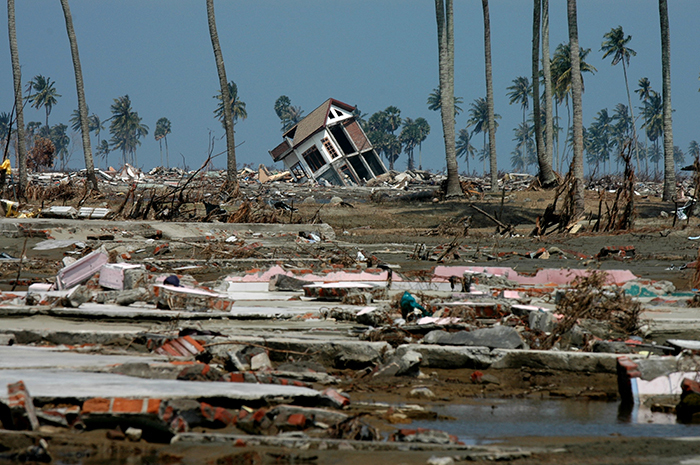
Learning Check Point
We will spend a few minutes also revisiting the accounts of historic tsunami events – in particular, the 1960 event and its effects in Chile and Hilo, Hawaii, and the important messages about how to survive a tsunami. Please re-read some of the accounts of survival during tsunami events in Heed Natural Warnings .
- IAS Preparation
- This Day in History
- This Day In History Dec - 26
Tsunami Struck the Indian Ocean - [December 26, 2004] This Day in History
On 26 December 2004, a megathrust earthquake with its epicentre off the west coast of Sumatra, Indonesia struck the Indian Ocean and triggered a series of devastating tsunamis that affected 14 countries including India, killing a total of about 2,80,000 people.
This is an important day in history. Aspirants can read about other important ‘ This Day in History ‘ topics from the linked article.
Aspirants would find this article very helpful while preparing for the IAS Exam .
Indian Ocean Tsunami
- A tsunami or a seismic sea wave is a series of waves that are caused in a large water body like an ocean by the displacement of massive volumes of water. The displacement can occur due to earthquakes , volcanic eruptions, landslides, meteorite impacts, underwater explosions, etc.
- Tsunamis are sometimes called tidal waves because they resemble rapidly rising tides, but scientists avoid this usage since tides are caused by the gravitational pull of the sun and the moon whereas tsunamis are caused by water displacement.
- The 2004 tsunami was caused by a massive earthquake that was the third-largest earthquake ever recorded on a seismograph. It measured between 9.1 and 9.3-moment magnitude. The duration of faulting was between 8.3 and 10 minutes and this was the longest ever.
- The epicentre was in the Indian Ocean between Simeulue and mainland Indonesia.
- The scientific community named this earthquake the Sumatra-Andaman Earthquake . It’s very high intensity makes it a megathrust earthquake.
- About 1600 km of fault surface slipped 15 m along the zone where the Indian Plate slides under the Burma Plate.
- It triggered several aftershocks for up to 3 to 4 months after the event. An enormous amount of energy was released as a result of the seismic activity and the earth is said to have wobbled minutely on its axis. The alteration in the mass and the energy released also caused a change in the earth’s rotation.
- Due to the earthquake, the seabed rose vertically by many metres displacing a huge volume of water thus, causing the tsunami.
- Indonesia was the first country to be hit by the tsunami because of its proximity. It also saw the maximum casualty, close to 1,70,000 being killed.
- The eastern coast of India was hit about 2 hours later sometime after 9:00 AM local time. Kerala was hit after another 2 hours. It also hit countries far away like Somalia, Tanzania and even South Africa. Bangladesh was spared the horror despite its nearness to the epicentre because the tsunami waves were in the east-west direction.
- The tsunami was also detected in Antarctica, Mexico and Vancouver in Canada.
While IAS Exam aspirants prepare geography-related topics, they come across various topics which need better understanding. Such topics are linked below:
Effects on India
- In India, the states of Tamil Nadu, Kerala and Andhra Pradesh were badly affected. The Andaman and Nicobar Islands were also severely affected. Fortunately, many of the aboriginal tribal people were safe thanks to their oral traditions and wisdom which made them flee to safer higher grounds before the tsunami struck.
- Before the tsunami struck taking people by surprise, they observed a “sea disappearing” effect, i.e, the sea retreated by as much as 2.5 km in some places. Many people who had come to witness this were submerged when the tsunami struck suddenly. The waves were as high as 100 feet in many places.
- In Thailand, many European vacationers were also affected.
- Countries that were affected by the disaster in approximate decreasing order of casualties: Indonesia, Sri Lanka, India, Thailand, Somalia, Myanmar, Maldives, Malaysia, Tanzania, Seychelles, Bangladesh, South Africa, Yemen, Kenya and Madagascar. Many European countries like Sweden and Germany also had a large number of victims.
- This 2004 tsunami was the deadliest recorded tsunami in history.
- The catastrophe triggered a massive wave of humanitarian aid from all over the world with governments, organisations and individuals contributing significantly.
- The tsunami also destroyed the economies of many communities, especially that relied on the sea for a living.
- In India, the coastal town of Nagapattinam in Tamil Nadu reported the most number of deaths with over 6000 people killed. Many villages were completely destroyed.
- The total damage caused due to the tsunami in 2004 is about USD 19.6 billion.
Candidates may also learn about disaster management from the related links below:
Indian Ocean Tsunami: Download PDF Here
For more information about the general pattern of the UPSC Exams, visit the UPSC Syllabus page. Candidates can also find additional UPSC preparation material and articles in the table below:
Related Links
Leave a Comment Cancel reply
Your Mobile number and Email id will not be published. Required fields are marked *
Request OTP on Voice Call
Post My Comment
IAS 2024 - Your dream can come true!
Download the ultimate guide to upsc cse preparation.
- Share Share
Register with BYJU'S & Download Free PDFs
Register with byju's & watch live videos.
Advertisement
Supported by
Dubai’s Extraordinary Flooding: Here’s What to Know
Images of a saturated desert metropolis startled the world, prompting talk of cloud seeding, climate change and designing cities for intensified weather.
- Share full article

By Raymond Zhong
Scenes of flood-ravaged neighborhoods in one of the planet’s driest regions have stunned the world this week. Heavy rains in the United Arab Emirates and Oman submerged cars, clogged highways and killed at least 21 people. Flights out of Dubai’s airport, a major global hub, were severely disrupted.
The downpours weren’t a freak event — forecasters anticipated the storms several days out and issued warnings. But they were certainly unusual. Here’s what to know.
Heavy rain there is rare, but not unheard-of.
On average, the Arabian Peninsula receives a scant few inches of rain a year, although scientists have found that a sizable chunk of that precipitation falls in infrequent but severe bursts, not as periodic showers.
U.A.E. officials said the 24-hour rain total on Tuesday was the country’s largest since records there began in 1949 . But parts of the nation had experienced an earlier round of thunderstorms just last month.
Oman, with its coastline on the Arabian Sea, is also vulnerable to tropical cyclones. Past storms there have brought torrential rain, powerful winds and mudslides, causing extensive damage.
Global warming is projected to intensify downpours.
Stronger storms are a key consequence of human-caused global warming. As the atmosphere gets hotter, it can hold more moisture, which can eventually make its way down to the earth as rain or snow.
But that doesn’t mean rainfall patterns are changing in precisely the same way across every corner of the globe.
In their latest assessment of climate research , scientists convened by the United Nations found there wasn’t enough data to have firm conclusions about rainfall trends in the Arabian Peninsula and how climate change was affecting them. The researchers said, however, that if global warming were to be allowed to continue worsening in the coming decades, extreme downpours in the region would quite likely become more intense and more frequent.
The role of cloud seeding isn’t clear.
The U.A.E. has for decades worked to increase rainfall and boost water supplies by seeding clouds. Essentially, this involves shooting particles into clouds to encourage the moisture to gather into larger, heavier droplets, ones that are more likely to fall as rain or snow.
Cloud seeding and other rain-enhancement methods have been tried across the world, including in Australia, China, India, Israel, South Africa and the United States. Studies have found that these operations can, at best, affect precipitation modestly — enough to turn a downpour into a bigger downpour, but probably not a drizzle into a deluge.
Still, experts said pinning down how much seeding might have contributed to this week’s storms would require detailed study.
“In general, it is quite a challenge to assess the impact of seeding,” said Luca Delle Monache, a climate scientist at the Scripps Institution of Oceanography in La Jolla, Calif. Dr. Delle Monache has been leading efforts to use artificial intelligence to improve the U.A.E.’s rain-enhancement program.
An official with the U.A.E.’s National Center of Meteorology, Omar Al Yazeedi, told news outlets this week that the agency didn’t conduct any seeding during the latest storms. His statements didn’t make clear, however, whether that was also true in the hours or days before.
Mr. Al Yazeedi didn’t respond to emailed questions from The New York Times on Thursday, and Adel Kamal, a spokesman for the center, didn’t immediately have further comment.
Cities in dry places just aren’t designed for floods.
Wherever it happens, flooding isn’t just a matter of how much rain comes down. It’s also about what happens to all that water once it’s on the ground — most critically, in the places people live.
Cities in arid regions often aren’t designed to drain very effectively. In these areas, paved surfaces block rain from seeping into the earth below, forcing it into drainage systems that can easily become overwhelmed.
One recent study of Sharjah , the capital of the third-largest emirate in the U.A.E., found that the city’s rapid growth over the past half century had made it vulnerable to flooding at far lower levels of rain than before.
Omnia Al Desoukie contributed reporting.
Raymond Zhong reports on climate and environmental issues for The Times. More about Raymond Zhong

The Earthquake. It began at 7:59am local time on December 26, 2004, when a 9.1-magnitude earthquake struck off Sumatra in Indonesia. The earthquake was the third-biggest ever recorded at the time and lasted around 10 minutes. It displaced 30 cubic kilometres of water, unleashing a massive tsunami across the Indian Ocean. 2.
On December 26, 2004, at 7:59 am local time, an undersea earthquake with a magnitude of 9.1 struck off the coast of the Indonesian island of Sumatra. Over the next seven hours, a tsunami —a series of immense ocean waves—triggered by the quake reached out across the Indian Ocean, devastating coastal areas as far away as East Africa.
The 2004 Indian Ocean Earthquake: A Case Study • Dec 26, 2004: Magnitude 9.3 (moment mag) • Undersea (depth 30 km) • Epicentre of the W coast of Sumatra • Tsunami followed, killing 225,000 in 11 countries • Caused by subduction: A 1600 km faultline slipped ~15 m along the subduction zone with the India plate slides under the Burma
Indian Ocean Tsunami 2004 A very common case study for earthquakes is the South-East Asian tsunami of 2004. Other case studies include Mexico 1985, San Francisco 1989, Kobe 1995 and Pakistan 2005.
A 2006 study estimated a magnitude of M w 9.1-9.3; ... In one river mouth, many boats were damaged. The tsunami moved counter-clockwise around Phuket Island, as was the case at Okushiri Island in the 1993 Hokkaido earthquake. According to ... Before 2004, the tsunami created in both Indian and Pacific Ocean waters by the 1883 eruption of ...
Countries affected by the 2004 Indian Ocean earthquake. According to official estimates in India, 10,749 people were killed, 5,640 people were missing and thousands of people became homeless when a tsunami triggered by the 2004 Indian Ocean earthquake near the Indonesian island of Sumatra struck the southern coast on 26 December 2004. The earthquake registered 9.1-9.3 M w and was the largest ...
Sometimes known as the Christmas or Boxing Day tsunami, the December 26, 2004 Indian Ocean Tsunami is far from a distant memory, a decade after resulting in more than 200,000 casualities. "The tsunami struck after the magnitude 9.1 Sumatra-Andaman Earthquake occurred off the northwest coast of Sumatra, Indonesia, causing catastrophic levels ...
December 26, 2021, marks 17 years since the devastating Indian Ocean earthquake and tsunami of 2004 which struck the coasts of multiple countries in south and southeast Asia and took a fatal toll ...
1. Introduction [2] The megathrust earthquake that struck near Indonesia on 26 December 2004 at 0h58′53″ UTC (+7h for Thailand local time) was likely the 3rd largest earthquake ever recorded [Stein and Okal, 2005].From its epicenter, located 80 km west of the coast of northern Sumatra (at approximately 95°51′W, 3°25′N), the earthquake proceeded approximately northward, rupturing 1200 ...
Indian Ocean Tsunami 2004 Cause An earthquake of magnitude 9.1 due to the rupture of the Sunda Megathrust fault caused the seabed to rise by 15m for over 1500 km. This caused a 30m wave. The Sunda Megathrust fault is a destructive plate boundary between the Burma plate and the subducting Indo-Australian Plate.
2004 Tsunami Case Study Presentation By EROS History Project October 8, 2019. 2004 Tsunami Case Study Presentation.pdf (901.36 KB) Detailed Description. 2004 Tsunami Case Study Presentation. Sources/Usage. Public Domain. Explore Search. Climate; EROS History Project; earth resources observation and science center; 2000s;
The Great Sumatra earthquake of 26 December 2004 did not cause shaking-induced damage to the mainland of India, but the consequent Indian Ocean tsunami had a sig-nificant effect on the southern peninsular region of India Jain et al. 2005 . The tsunami severely affected the coastal regions of the eastern state of Tamil Nadu, the union terri-
Comprehending the Indian Ocean Tsunami: Dec 26, 2004 Case study: E-Book. This web-exhibit should be cited as the following: Vernekar, S. & Kant, V., Comprehending the Indian Ocean Tsunami:Dec 26, 2004. ... The book revisits the 2004 Indian Ocean Tsunami and it's aftermath from the viewpoint of resilience and vulnerability. Vulnerability is a ...
Tectonic activity & hazards > Tsunamis > Case study: Indian Ocean, 2004. Overview. On December 20, a magnitude 9.0 earthquake triggered a tsunami across the coastlines of the Indian Ocean; 1600 km of fault surface ruptured about 15 m along the subduction zone of the Indian plate under the Burma plate, displacing an estimated 30 cubic kilometres ...
The 2004 Indian Ocean tsunami was one of the most devastating tsunamis in world history. The tsunami caused damage to most of the Asian and other countries ... Riyaz, M. and Park, K. H. (2010) "Safer Island Concept" developed after the 2004 Indian Ocean tsunami: A case study of Maldives, Journal of Earthquake and Tsunami, 4 (2), 135-143.
Modeling the 26 December 2004 Indian Ocean tsunami: Case study of impact in Thailand. M. Ioualalen, M. Ioualalen [email protected] Geosciences Azur, IRD-CNRS-UPMC-UNSA, Villefranche-sur-Mer, France. ... The devastating 26 December 2004 Indian Ocean tsunami stressed the need for assessing tsunami hazard in vulnerable coastal areas. Numerical ...
The history of the tsunami in India dates back from 1762 to 2004. About 18,000 people died in the 2004 tsunami. Tsunami-affected areas in India are West Bengal, Odisha, Andhra Pradesh, Tamil Nadu ...
In response to the enormous loss of life in the 2004 Indian Ocean tsunami, the Global Tsunami Warning and Mitigation System was put in place. The Indian Ocean tsunami warning system now integrates the signals from seismographs and DART Buoys and transmits data to 26 national centers. Warnings at the local level are generated in the form of SMS ...
Modeling the 26 December 2004 Indian Ocean tsunami: Case study of impact in Thailand M. Ioualalen,1 J. Asavanant,2 N. Kaewbanjak,2 S. T. Grilli,3 J. T. Kirby,4 and P. Watts5 Received 29 July 2006; revised 9 February 2007; accepted 19 April 2007; published 24 July 2007. [1] The devastating 26 December 2004 Indian Ocean tsunami stressed the need for
Subsequent to the 2004 Indian Ocean tsunami, post-disaster surveys and case studies were extensively conducted at Penang Island, Langkawi Island and Kuala Muda [19,20,21,22,23,24]. The variability of tsunami flow characteristics is based on a site-specific basis in terms of geomorphic setting.
The Indian Ocean Tsunami, December 26th 2004 Case Study. ... The Indian Ocean Tsunami Warning System was set up in June 2006, as before there had been no early-warning system. Ensuring people know how to respond, and that local authorities have plans in place are essential to its success.
The 2004 tsunami was caused by a massive earthquake that was the third-largest earthquake ever recorded on a seismograph. It measured between 9.1 and 9.3-moment magnitude. The duration of faulting was between 8.3 and 10 minutes and this was the longest ever. The epicentre was in the Indian Ocean between Simeulue and mainland Indonesia.
Case Study of the Indian Ocean Tsunami On December 26, 2004, the Indian Ocean earthquake, or the Sumatra-Andaman earthquake, caused a tsunami that killed 230,000 people and was recorded as the deadliest tsunami in known history. The earthquake was recorded as between 9. 1 and 9. 3 on the Richter scale, the second largest earthquake ever recorded.
One recent study of Sharjah, the capital of the third-largest emirate in the U.A.E., found that the city's rapid growth over the past half century had made it vulnerable to flooding at far lower ...

IMAGES
VIDEO
COMMENTS
The official Nightwish webshop is operated by Backstage Rock Shop in co-operation with the band. Find your favorite Nightwish band shirt, hoodie, beanie or other merchandise item from our store. Wide range of exclusive merchandise and albums also available! We ship internationally, every working day.
Unisex T-shirt in black featuring Nightwish "Since 1996 Tour 2022" artwork printed on the front and back. ... Nightwish. Since 1996 Tour 2022 T-Shirt. Favorites Login. FAST SHIPPING. PRICE MATCH GUARANTEE. EASY RETURNS. RESPONSIVE SERVICE. Favorites Login. Always Official. Shopping CartEdit Cart. You have no items in your cart. Home; Hard Rock.
Nightwish announces new album 'Yesterwynde'. April 30, 2024. Yesterwynde is a fantastical voyage through time, memory, and the better angels of human nature. Three years in the making, we're thrilled beyond words to share our tenth album with the world on September 20th! read more.
Nightwish - Officially Licensed Merchandise. Nightwish is a symphonic metal band from Kitee, Finland. The band was formed in 1996. Memebers include; Tuomas Holopainen, Emppu Vuorinen, Jukka Nevalainen, Marco Hietala, Troy Donockley, Floor Jansen. Discography Includes; Angels Fall First (1997), Oceanborn (1998), Wishmaster (2000), Century ...
European Tour Dates 2022 Confirmed! Nightwish release "Nemo (Virtual World Version)" exclusively available on Amazon Music Nightwish Reschedules Latin American Tour Dates
Nightwish. $39.95 - $41.95. or 4 interest-free installments of $9.99 by ⓘ. Availability Ships in 3-5 Business Days. 20% Off Orders $150+. Discount Automatically Applied at Checkout. Size Chart. a Size Required. Small Medium Large X-Large XX-Large XXX-Large.
Product Details. Styles. Fantasy Metal, Symphonic Metal, Power Metal, Opera Metal, Gothic Symphonic Metal, Gothic Metal, Finnish Power Metal, Finnish Metal. Categories. Shirts > T-Shirts. Be first to know about Nightwish merch. Sign Me Up. Unisex T-shirt in black featuring Nightwish "Decades Tour North America" artwork printed on the front and ...
Shop high-quality unique Nightwish Tour T-Shirts designed and sold by independent artists. Available in a range of colours and styles for men, women, and everyone. ... nightwish 2 loerrcok human nature world tour 2022 Classic T-Shirt. By janicestrev. From $19.58. Tags: live, nightwish, american, north, world, 2019, 2021, cover, album.
Unisex T-shirt in black featuring Nightwish "Wish Master Decades North American Tour" artwork printed on the front and back.
Nightwish 2022 North American Tour Dates. May 04 — Toronto, Ontario @ History May 06 — Montreal, Quebec @ Mtelus May 07 — Lowell, Mass. @ Tsongas Arena May 08 — New York, N.Y. @ Terminal 5
EMP Signature Collection Nightwish Hooded zip. € 37,99. Once Nightwish LP Coloured, Standard, Gatefold, REMASTERED. Exclusive to EMP. From € 34,99. Woe To All Nightwish T-Shirt. (1) Sustainable at EMP. € 69,99.
Shop Official Nightwish Merch, Accessories, Shirts and More. Shop Official Nightwish Merch, Accessories, Shirts and More. Skip to content FREE DOMESTIC SHIPPING ON ORDERS $75+ SHOP BY ARTIST SHOP BY ARTIST Abysmal Dawn AC/DC Amon Amarth ...
vintage NIGHTWISH Tour t-shirt official product black Size L big logo retro shirt 90s authentic band old rock Symphonic metal Finland folk (2k) $ 43.00. Add to Favorites Nightwish - 2008 World Concert Tour T-Shirt - L Large (120) $ 45.00. FREE shipping Add to Favorites Vintage 2000 Doro Pesch T-Shirt "Metal Queen" Warlock Band Heavy Metal ...
From $22.32. nightwish Essential T-Shirt. By bbalc. From $22.98. Tarja Soile Susanna Turunen Cabuli Classic T-Shirt. By Efdi. From $20.66. nightwish 2 loerrcok human nature world tour 2022 Classic T-Shirt. By janicestrev.
Nightwish - European Tour 2022. Louis Cypher Thu, 24/11/2022 - 10:47. TShirt or Longsleeve. Not for sale or trade. Year: 2022. Original TShirt Fabric Color: Black.
November 18, 2022. |: Ahead of our return to the European stages, kicking off this Sunday in Antwerpen, Belgium, we are proud to release the Human. :II: Nature. (Tour Edition) today! Get the album here! Including a Blu-ray Digipack of our live stream event, An Evening With Nightwish In A Virtual World. "This is definitely one of the coolest ...
So don't wait any longer, order your Nightwish European Tour 2022 Shirt, Human Ii Nature Short Sleeve Crewneck today! Features: Fabric Weight: 5.3 oz (mid-weight). 100% pre-shrunk cotton (heather gray color is 90% cotton/10% polyester, light heather gray is 98% cotton/2% polyester, heather black is 50% cotton/50% polyester) ...
See when Nightwish plays in your city and when the next world tour starts! Or find out when we play the biggest festivals! shop en. FI de Tour. Close. Close NEWS. BAND. MUSIC. TOUR. SHOP OFFICIAL. Nightwish Shop. OTHERS. emp Nuclear Blast. 02. About. 03. Blog. 03.
MOSCOW DAY TRIPS Get out of Moscow and take a relaxing trip to some of these places. ST. PETERSBURG Some of the sights to see in Petersburg. LAKE BAIKAL TOURS
2-hour tour $87: 10 Must-See Moscow Metro stations with hotel pick-up and drop-off. 3-hour tour $137: 20 Must-See Moscow Metro stations with Russian lunch in beautifully-decorated Metro Diner + hotel pick-up and drop off. Metro pass is included in the price of both tours.
Adres: BOSB Mermerciler San. Sitesi 4. Cadde No: 7 34520, Beylikdüzü / İstanbul / TÜRKİYE
Now, this is about to change with a full European tour taking place in November and December 2022. As a special, limited release right on time with tour start, on November 18 th, NIGHTWISH present the Human. :II: Nature. (Tour Edition) as luxurious 2CD plus Blu-ray Digipak including the recent album alongside the Virtual Live Show From The ...
Vintage 1996 Gary Numan The Premier tour 96 t shirt (238) $ 119.00. Add to Favorites Vintage 90's KRAFTWERK Shirt Big Logo (546) Sale Price $136.00 $ 136.00 $ 170.00 Original Price $170.00 (20% off) FREE shipping Add to Favorites Ultravox - Vintage 1984 Tour shirt Rare ( New Wave, Post-Punk, Synthpop, OMD, The Human League, Gary Numan, Visage .....